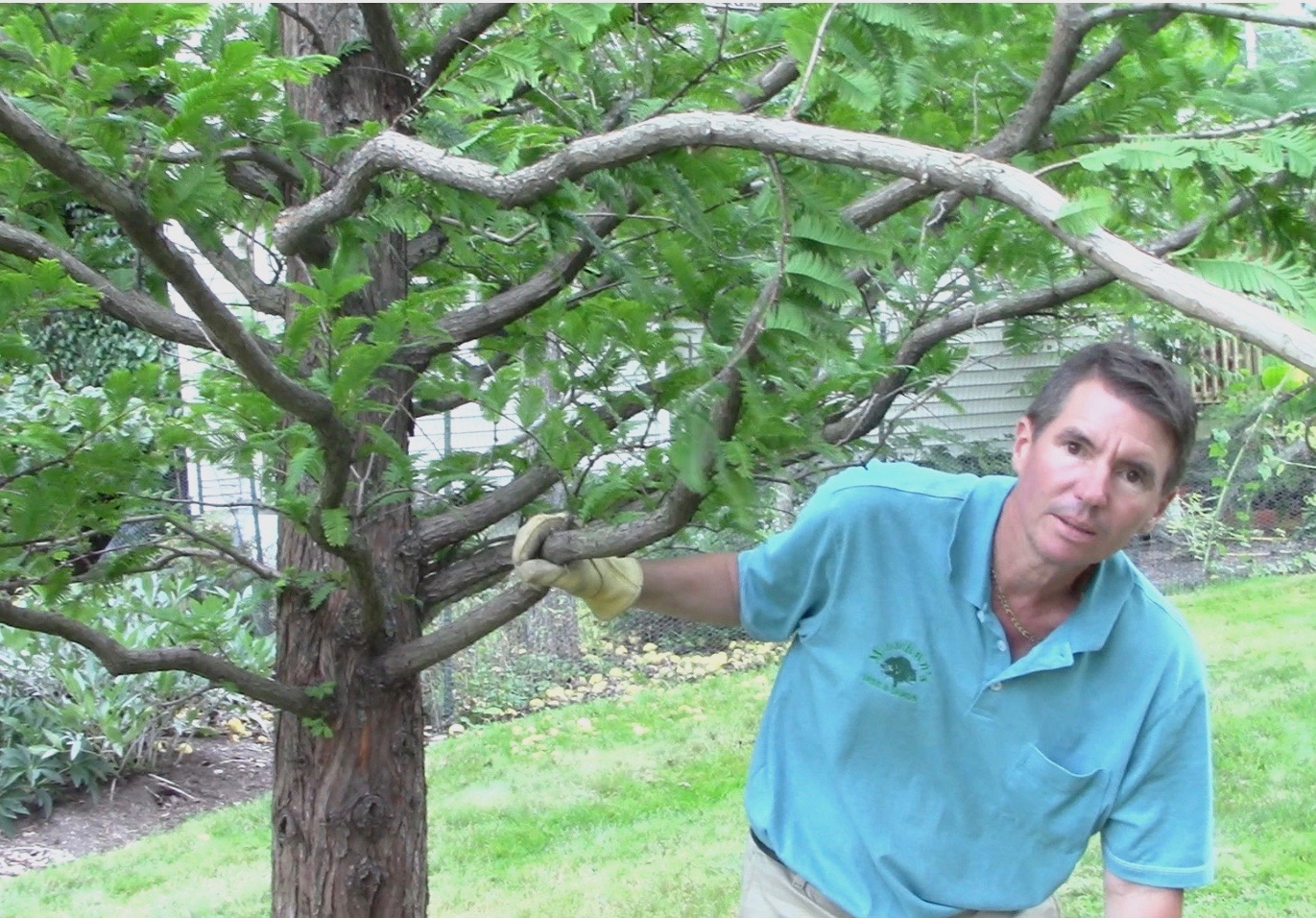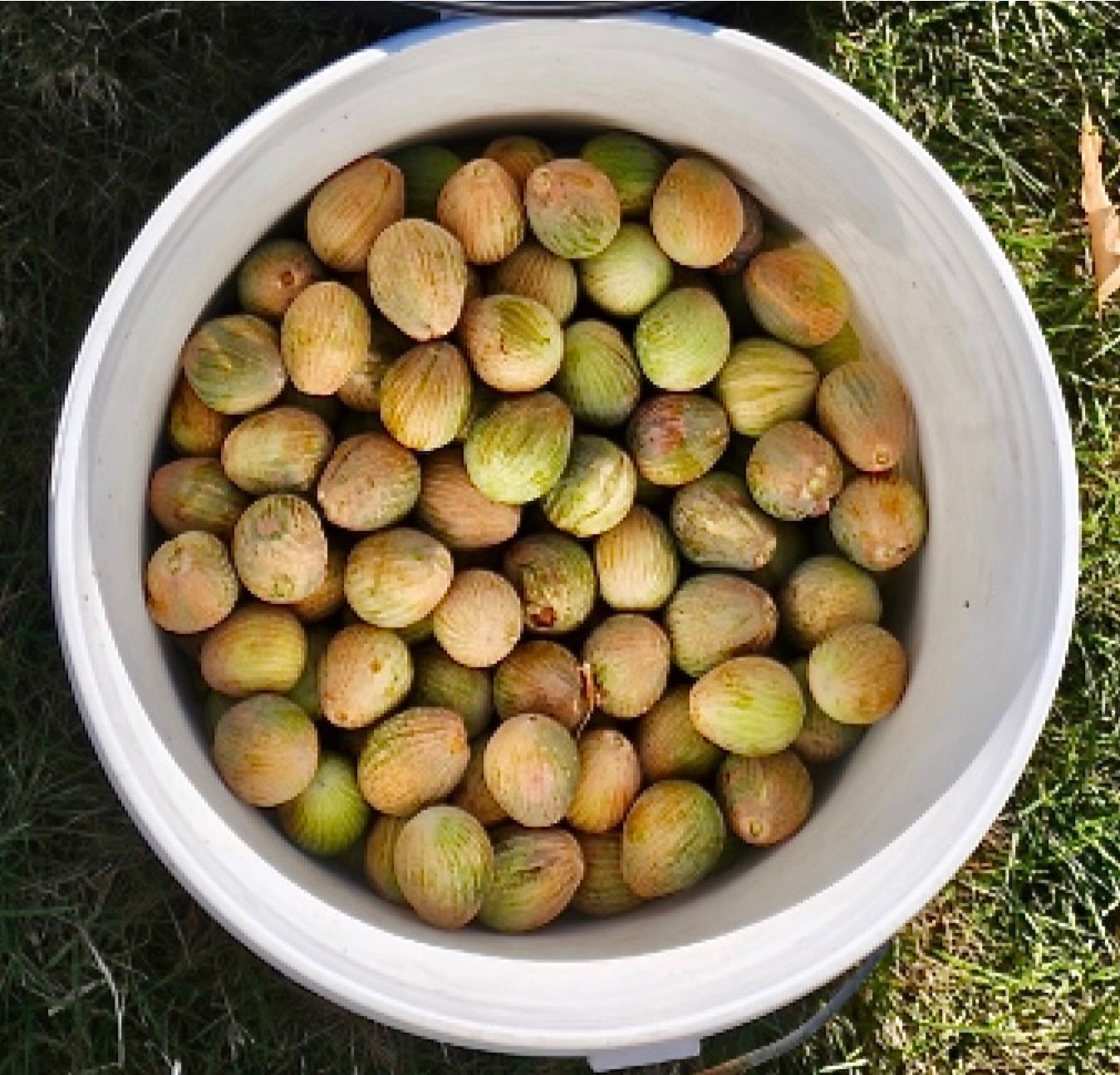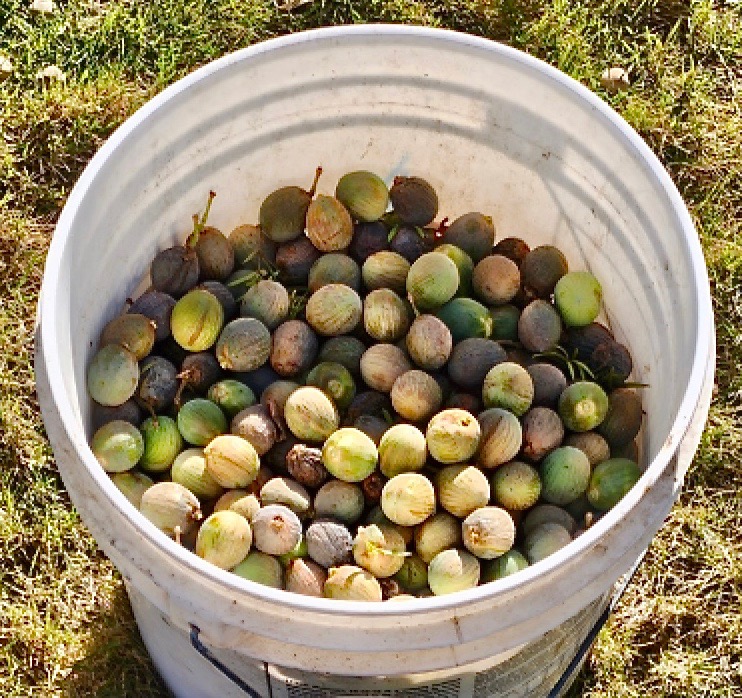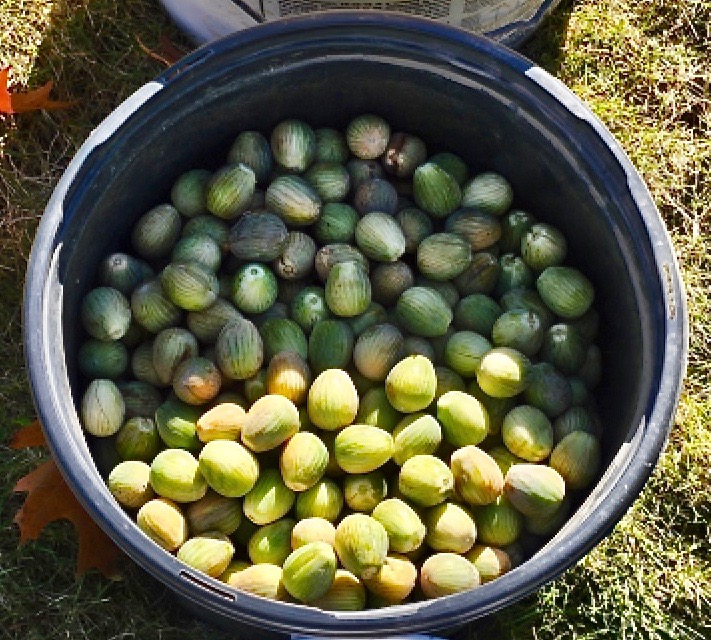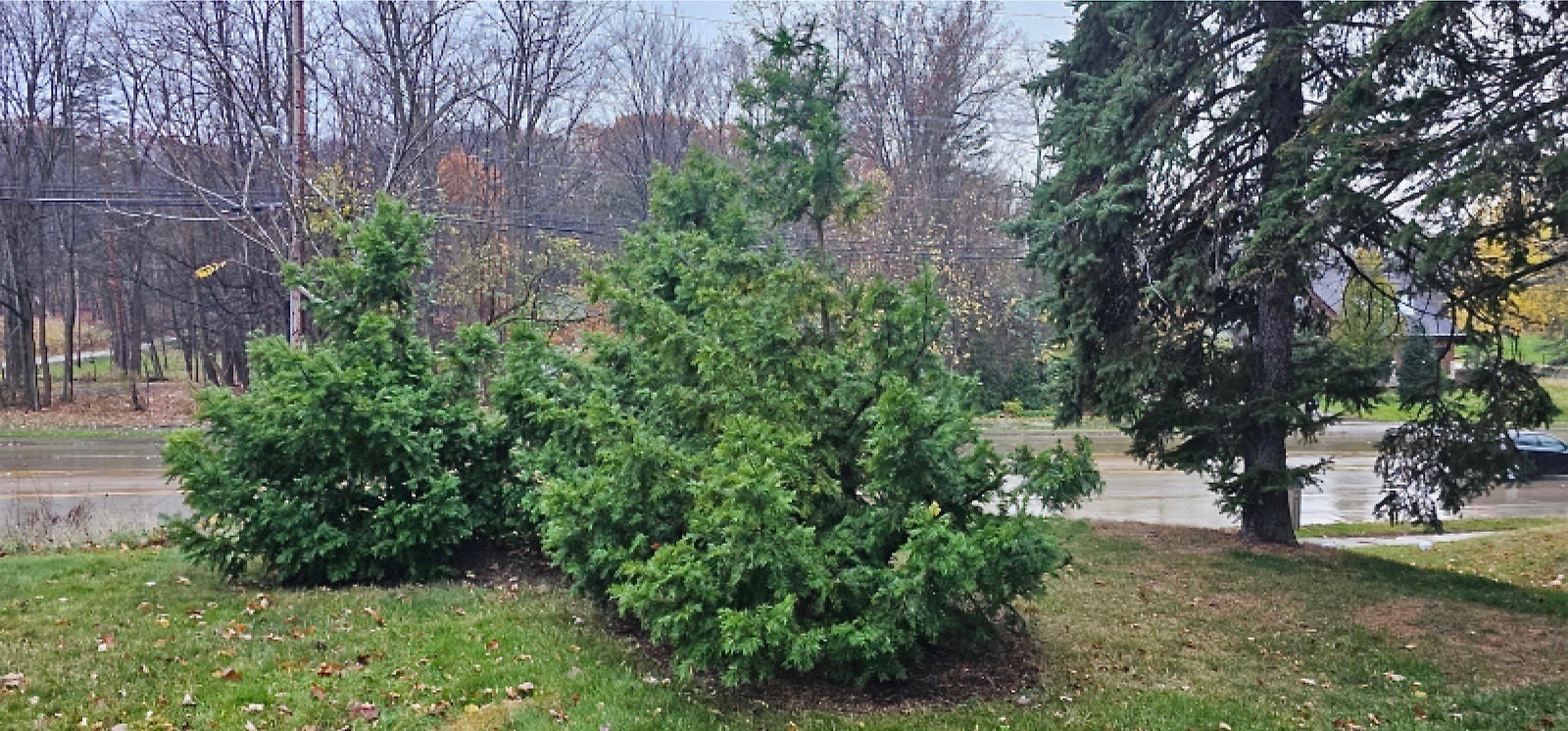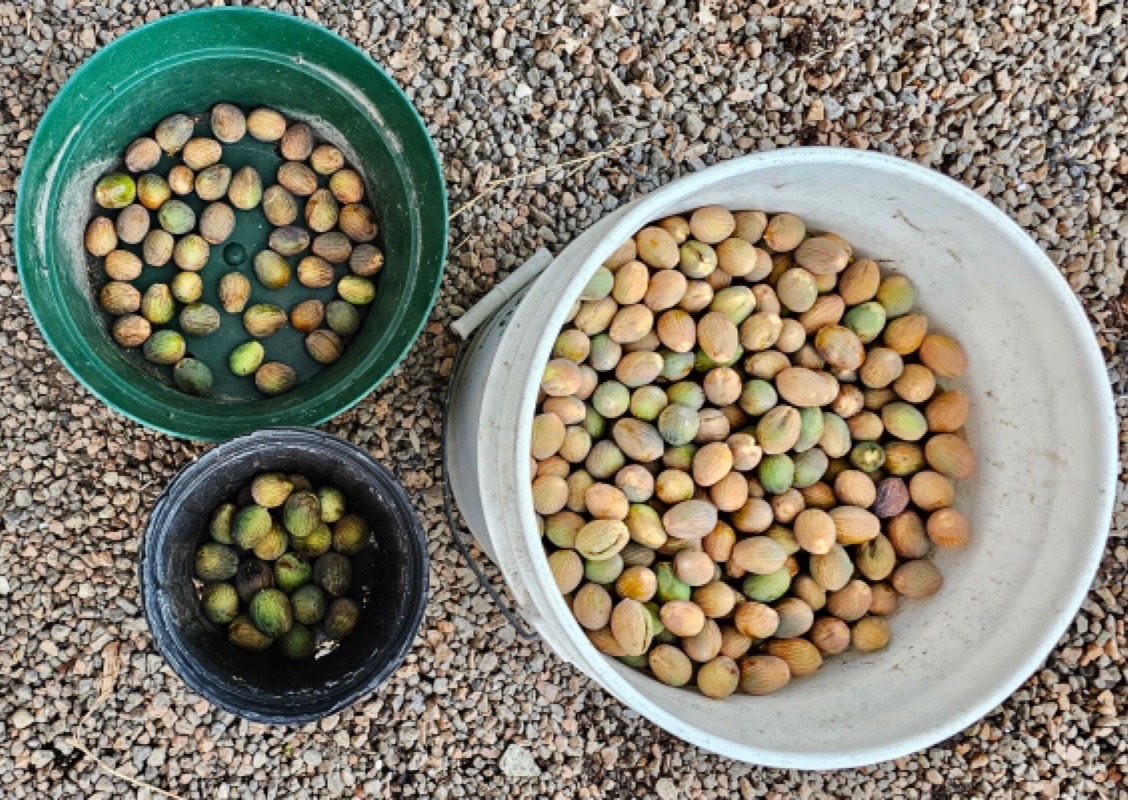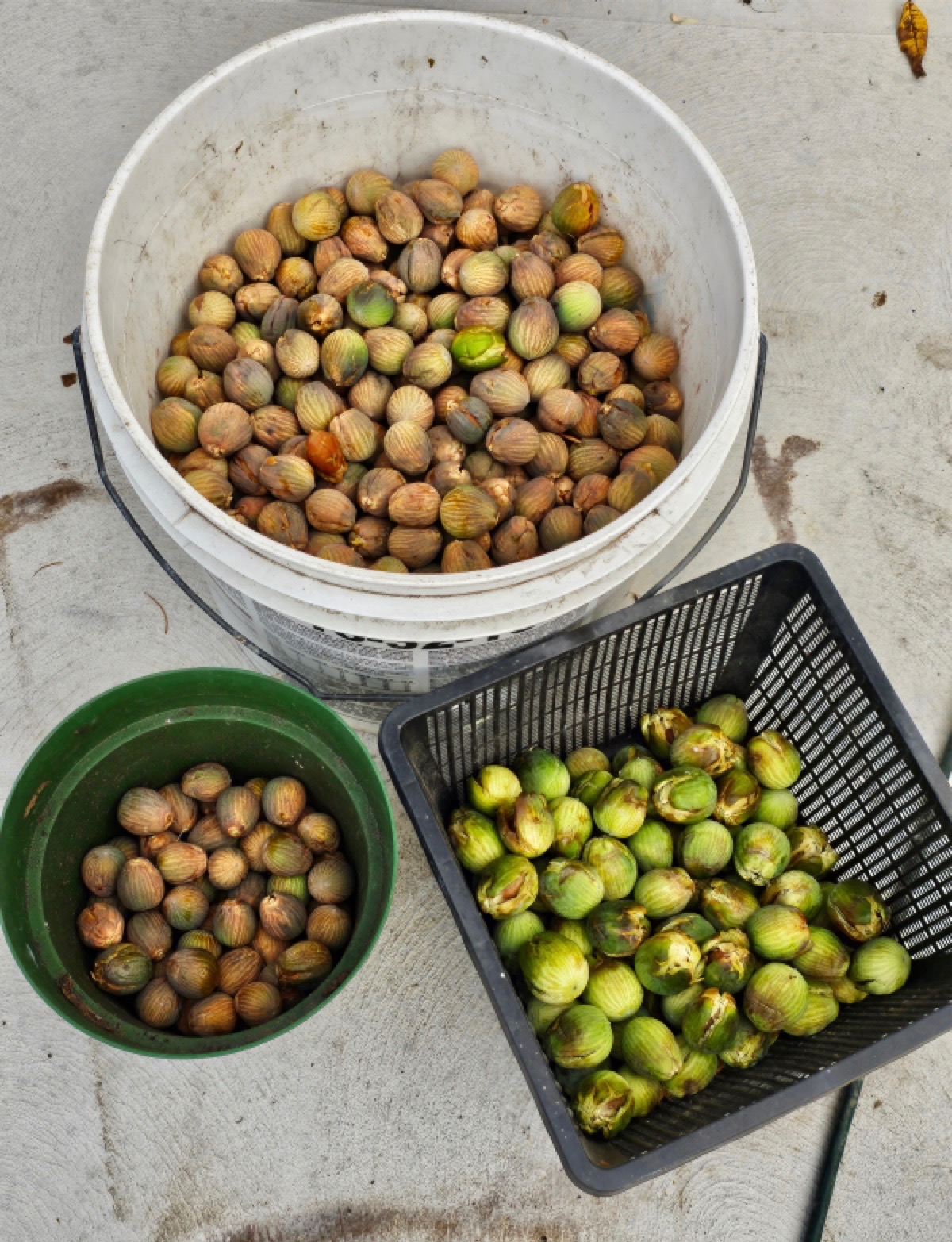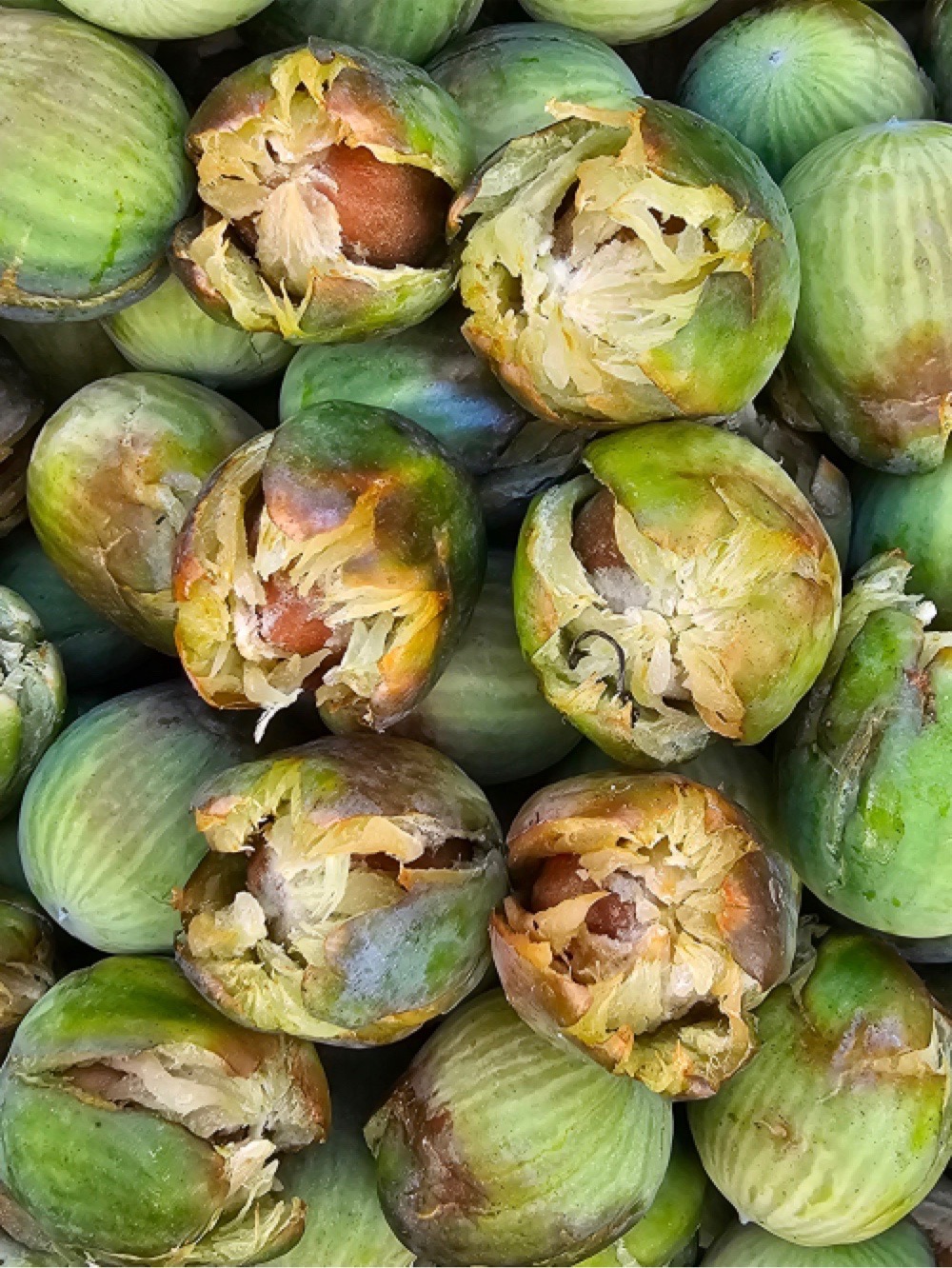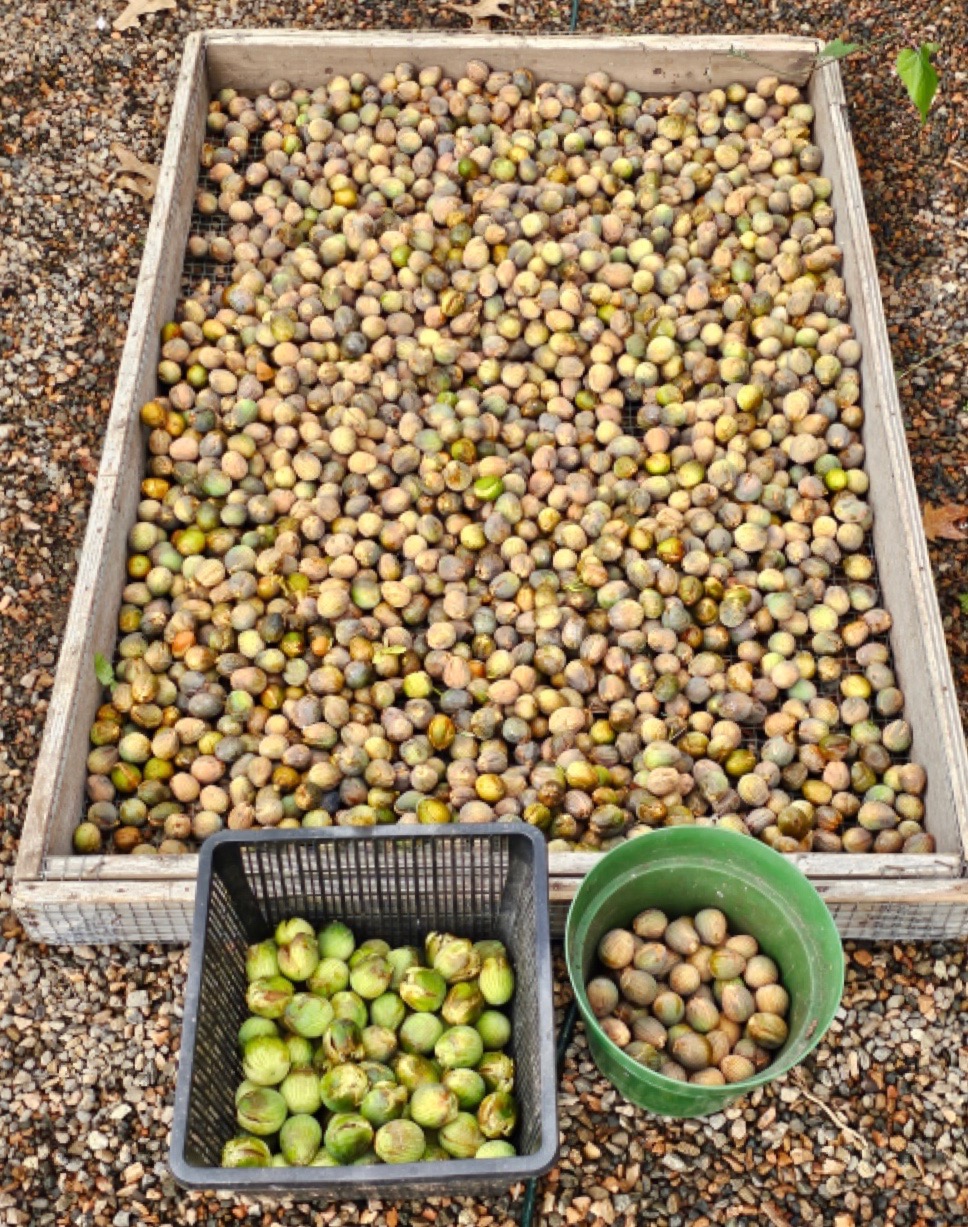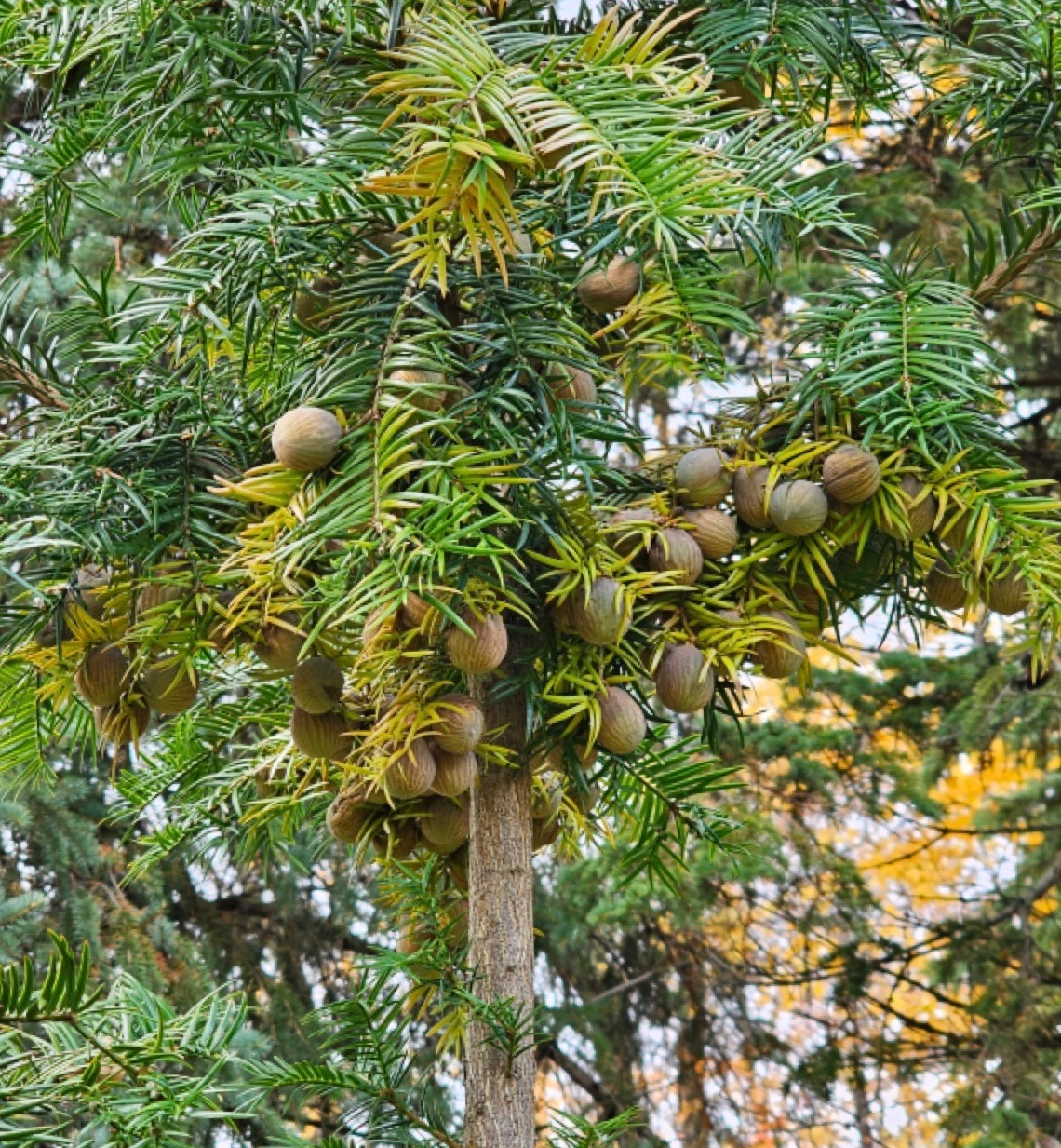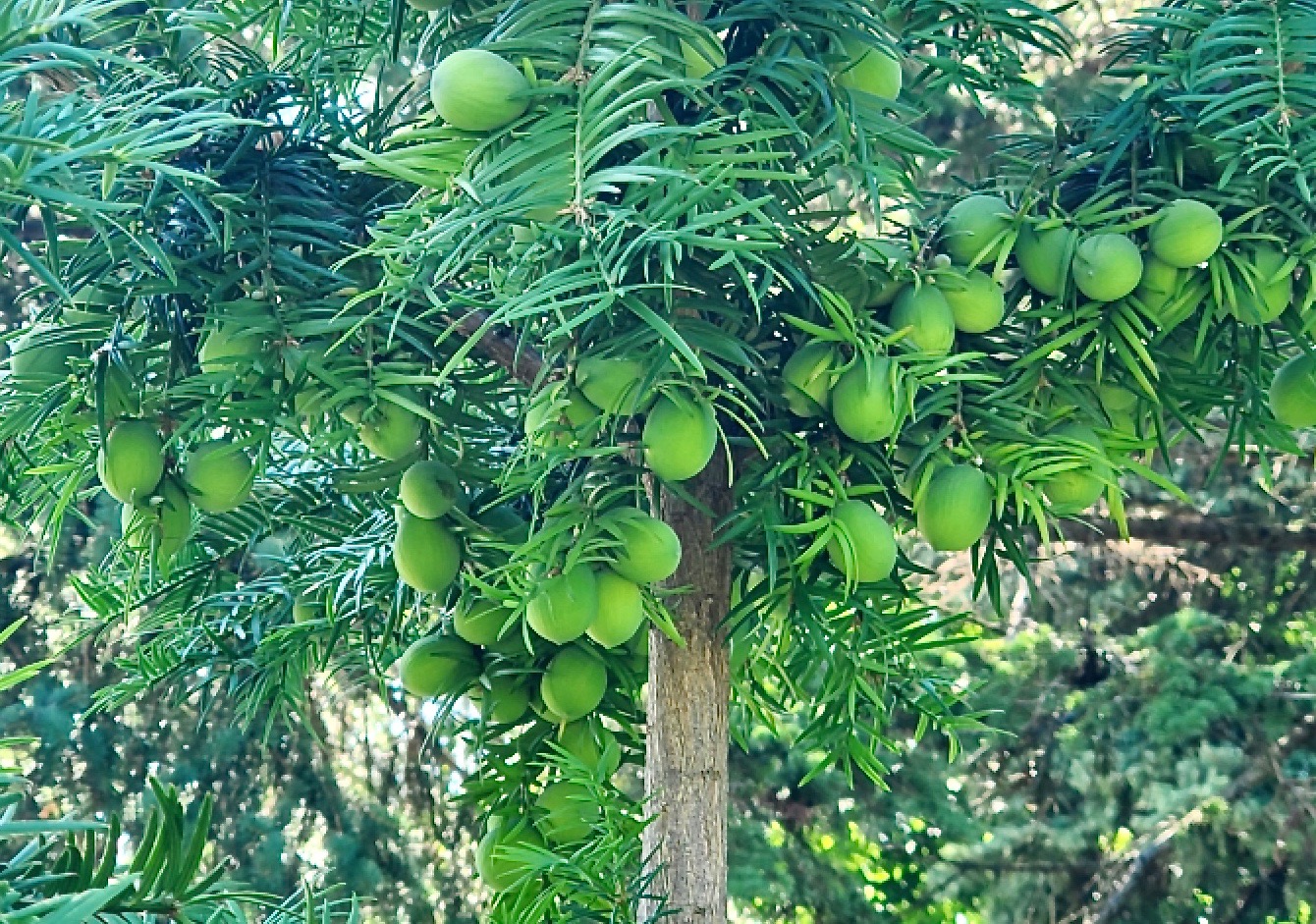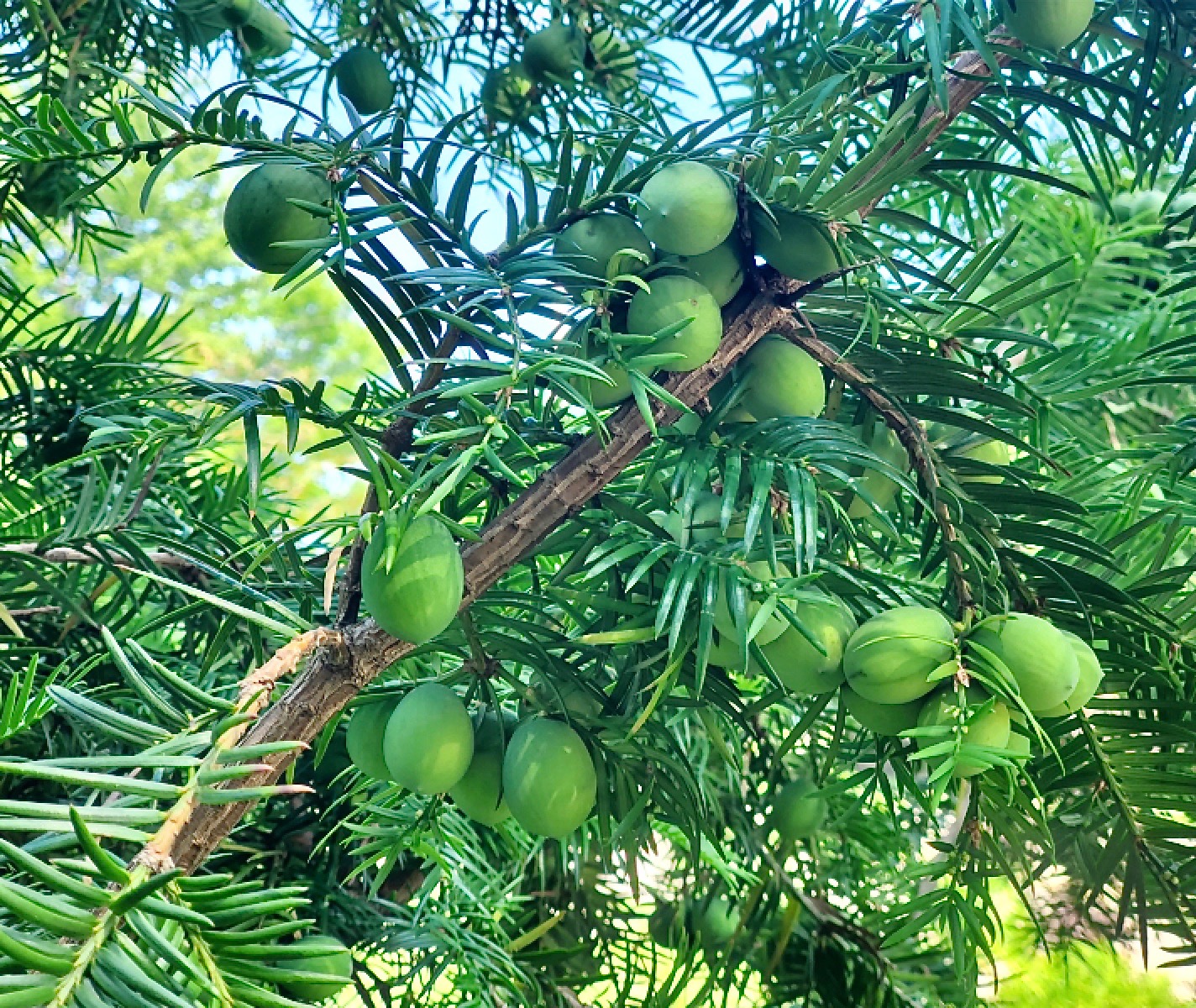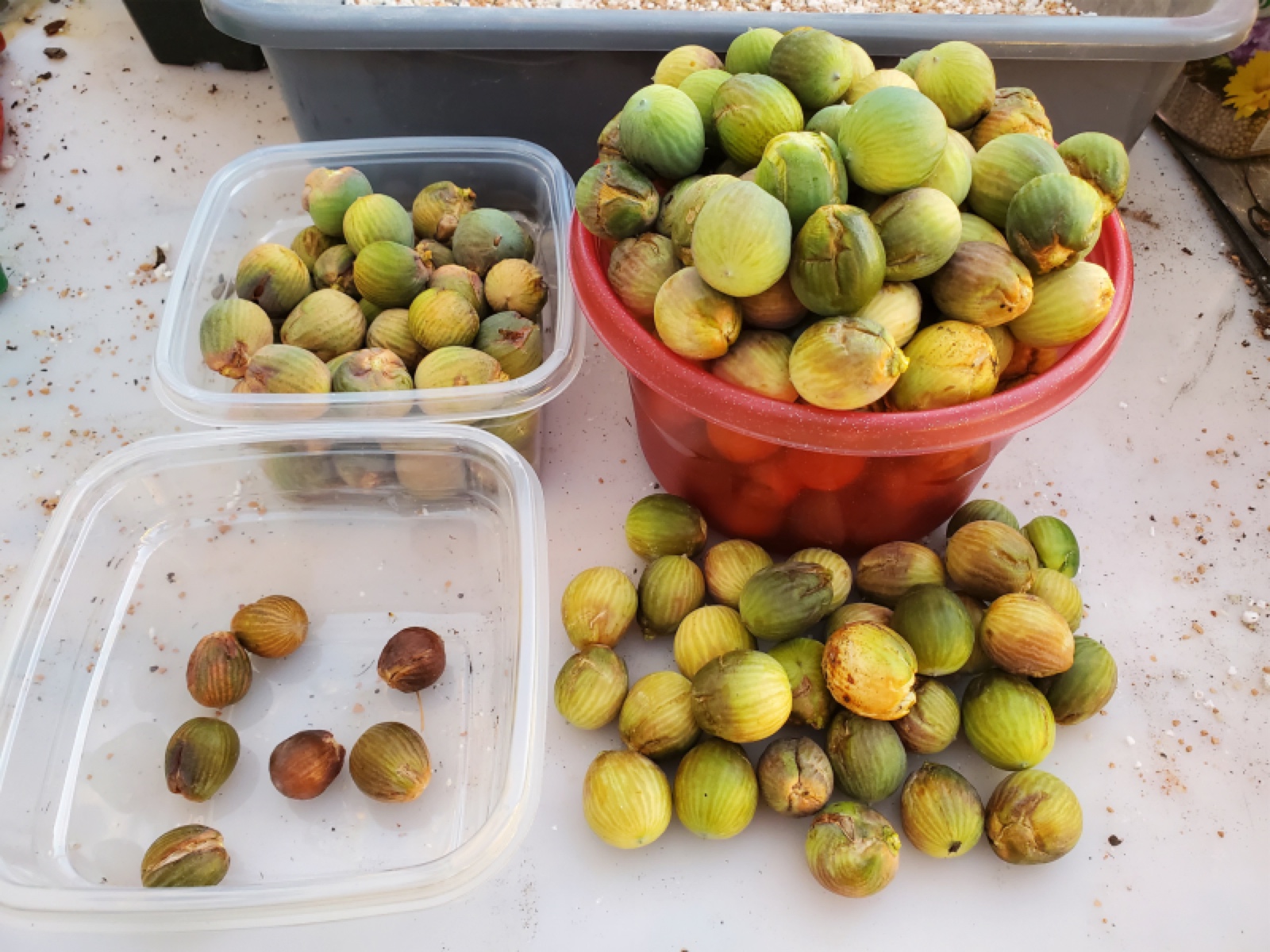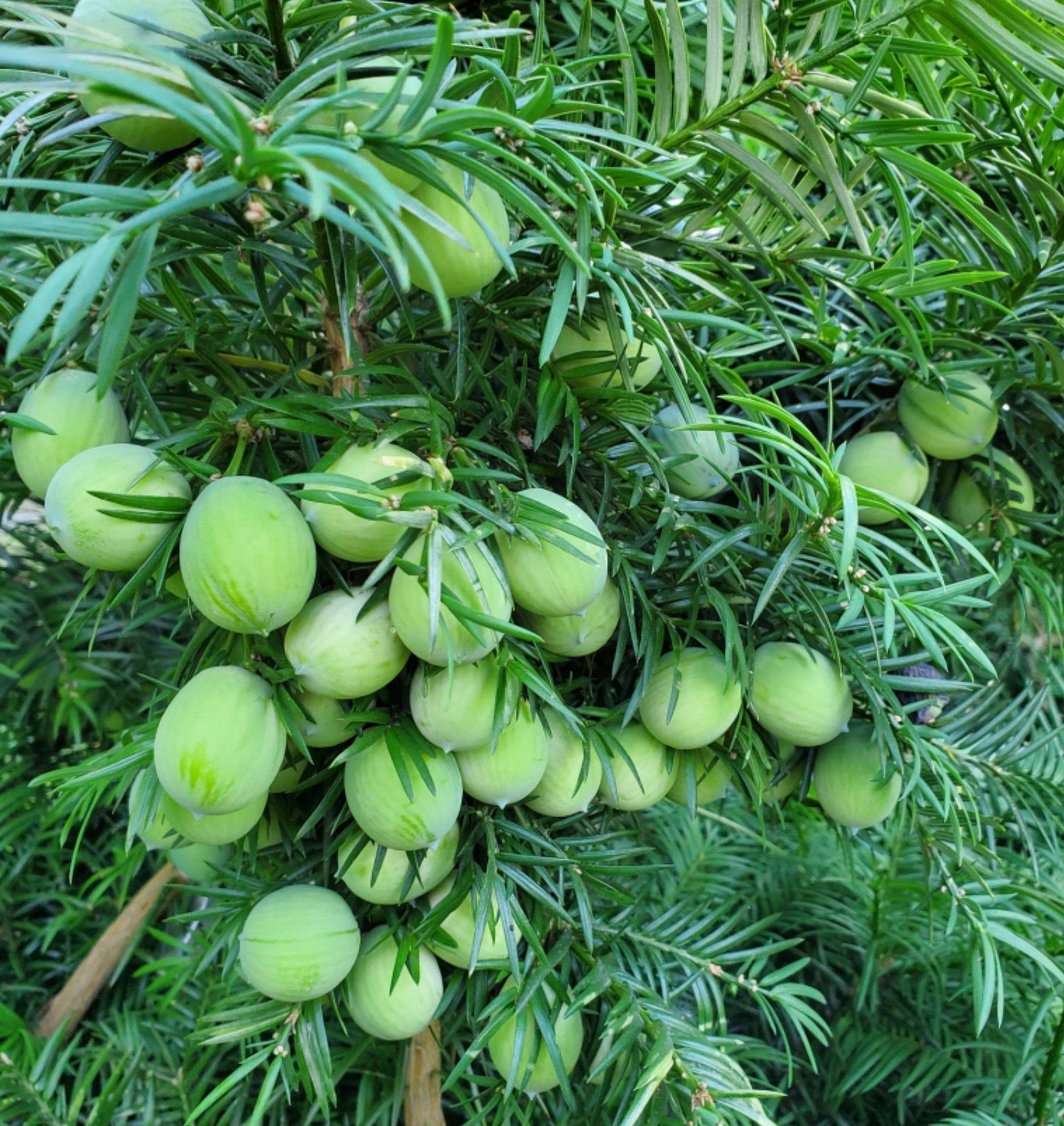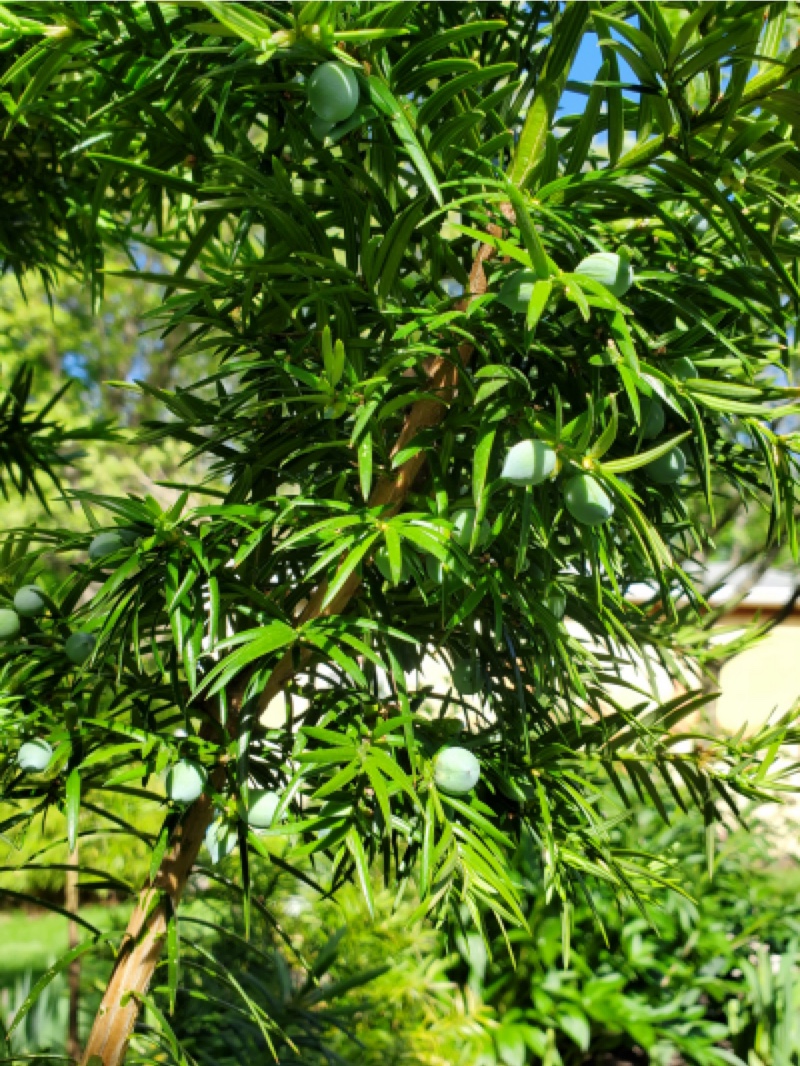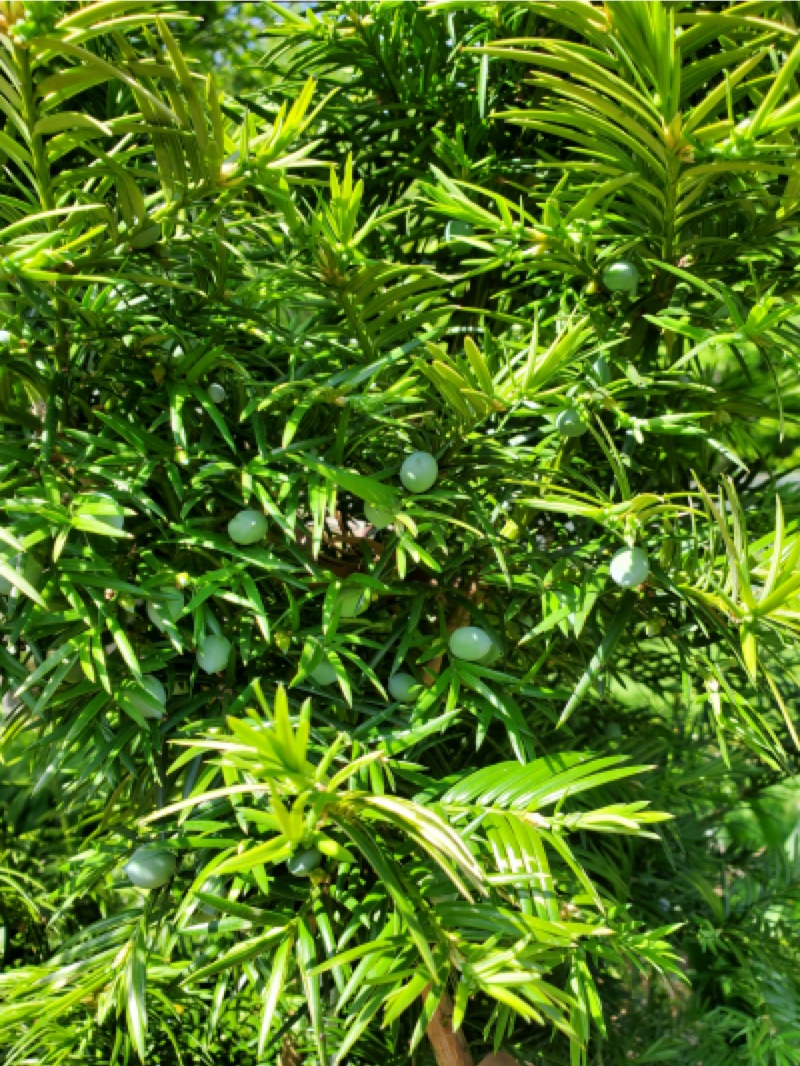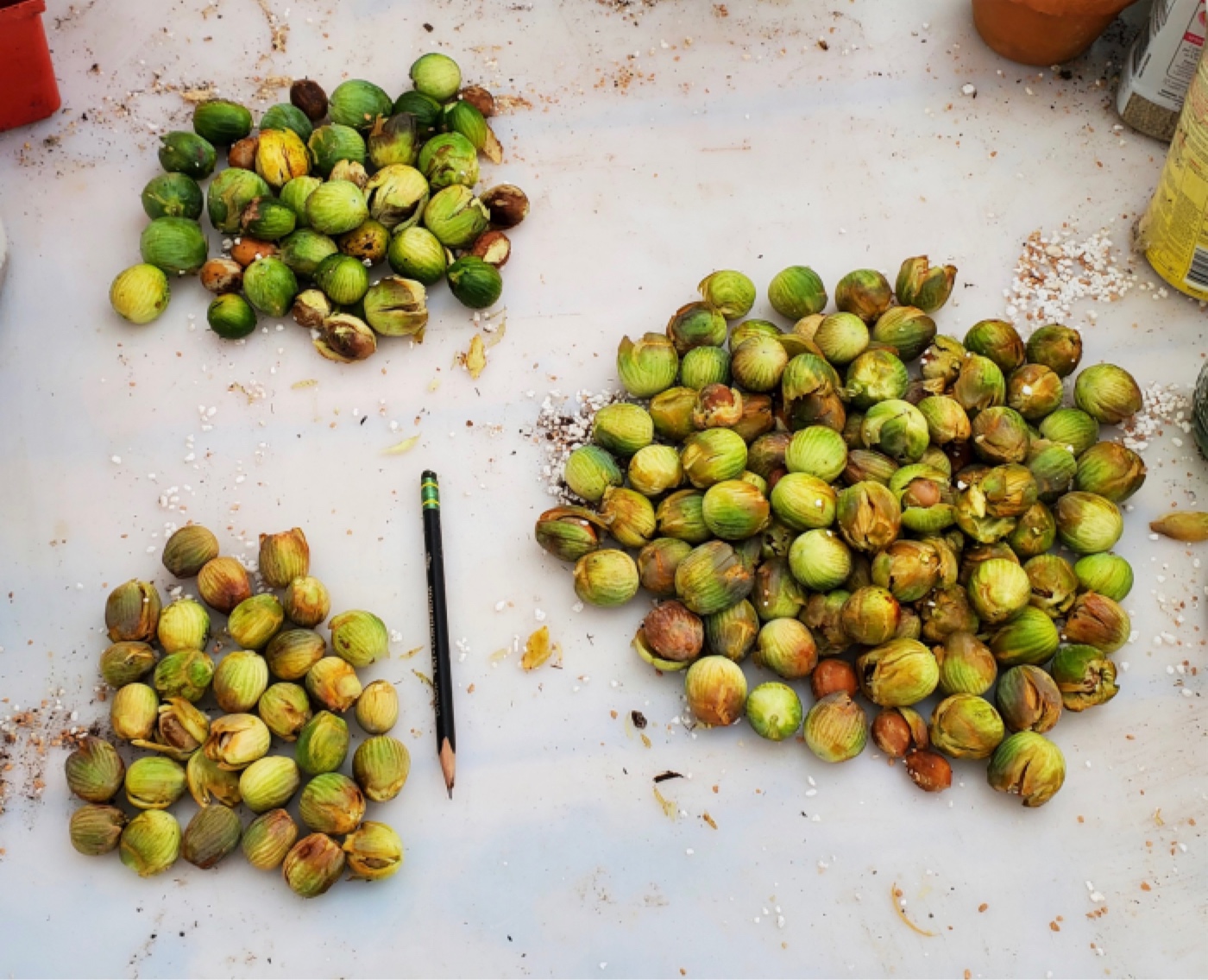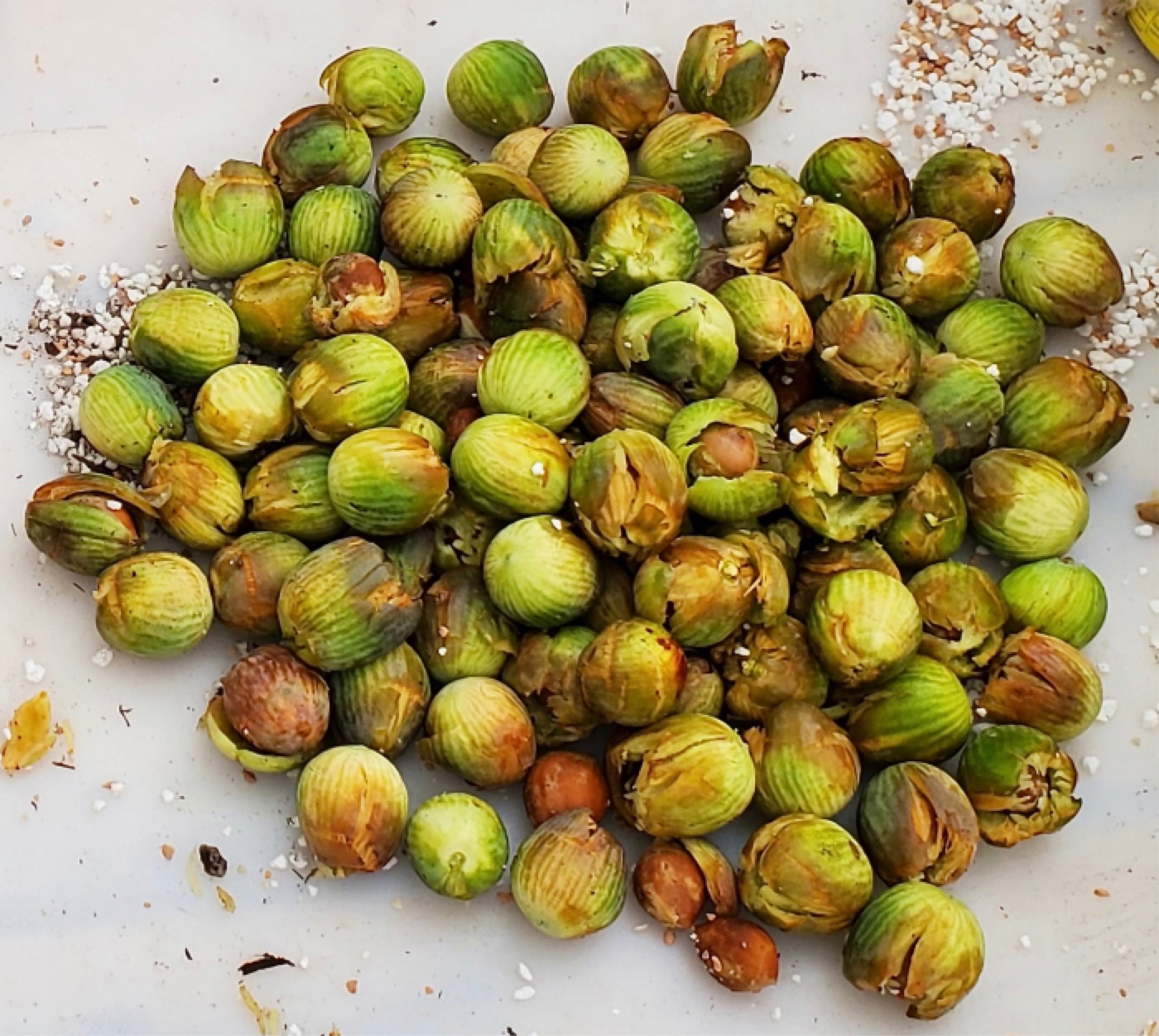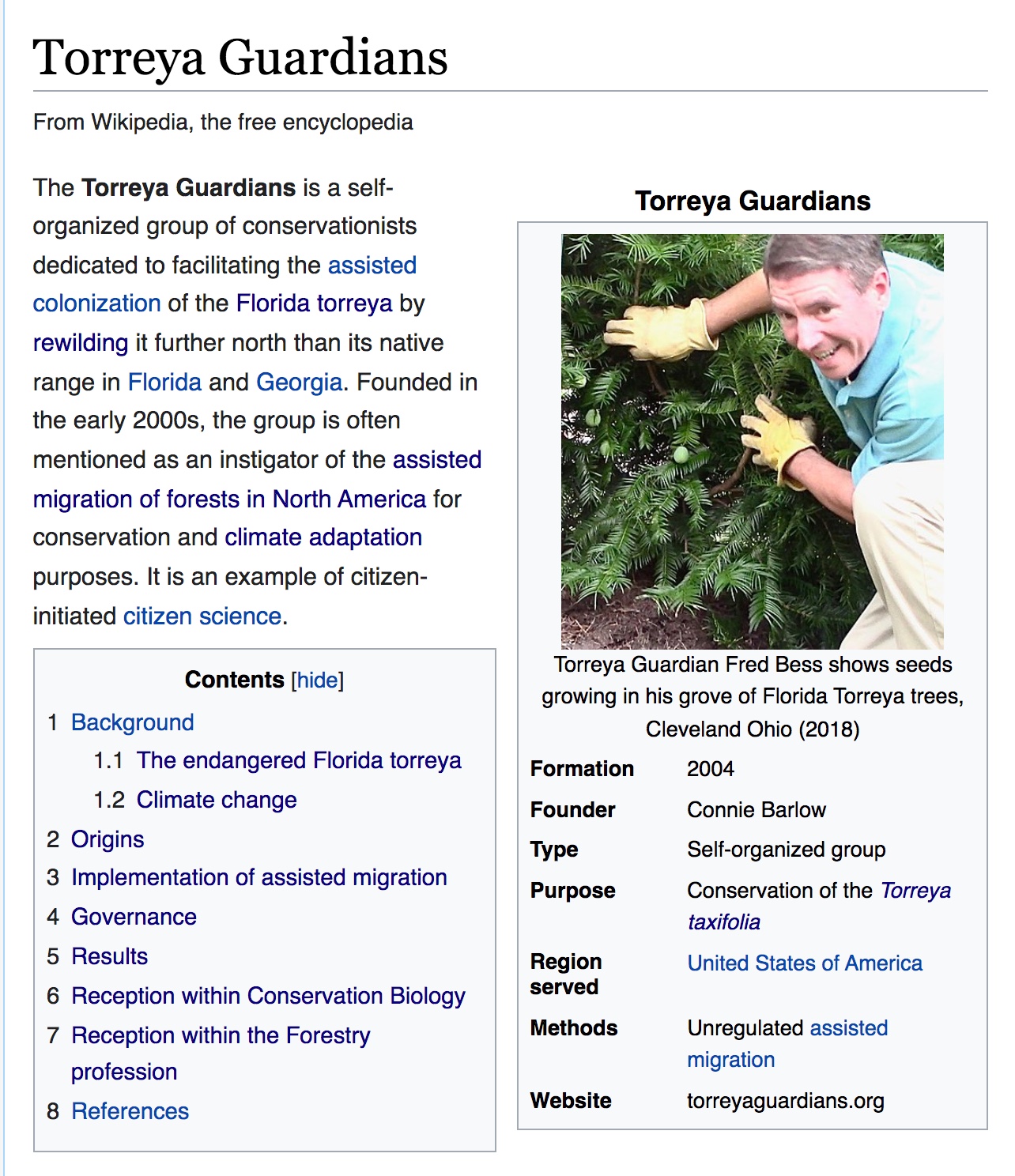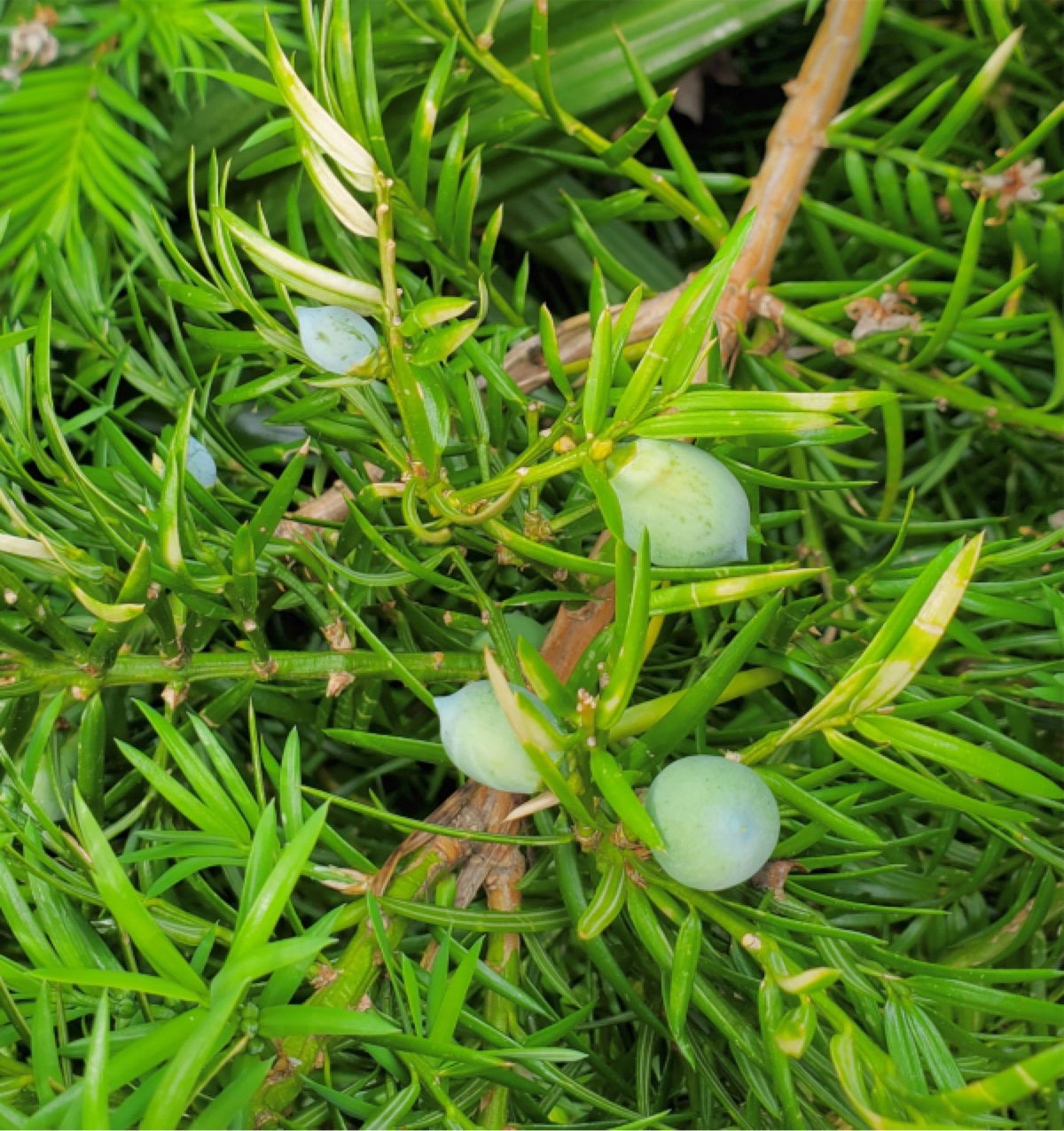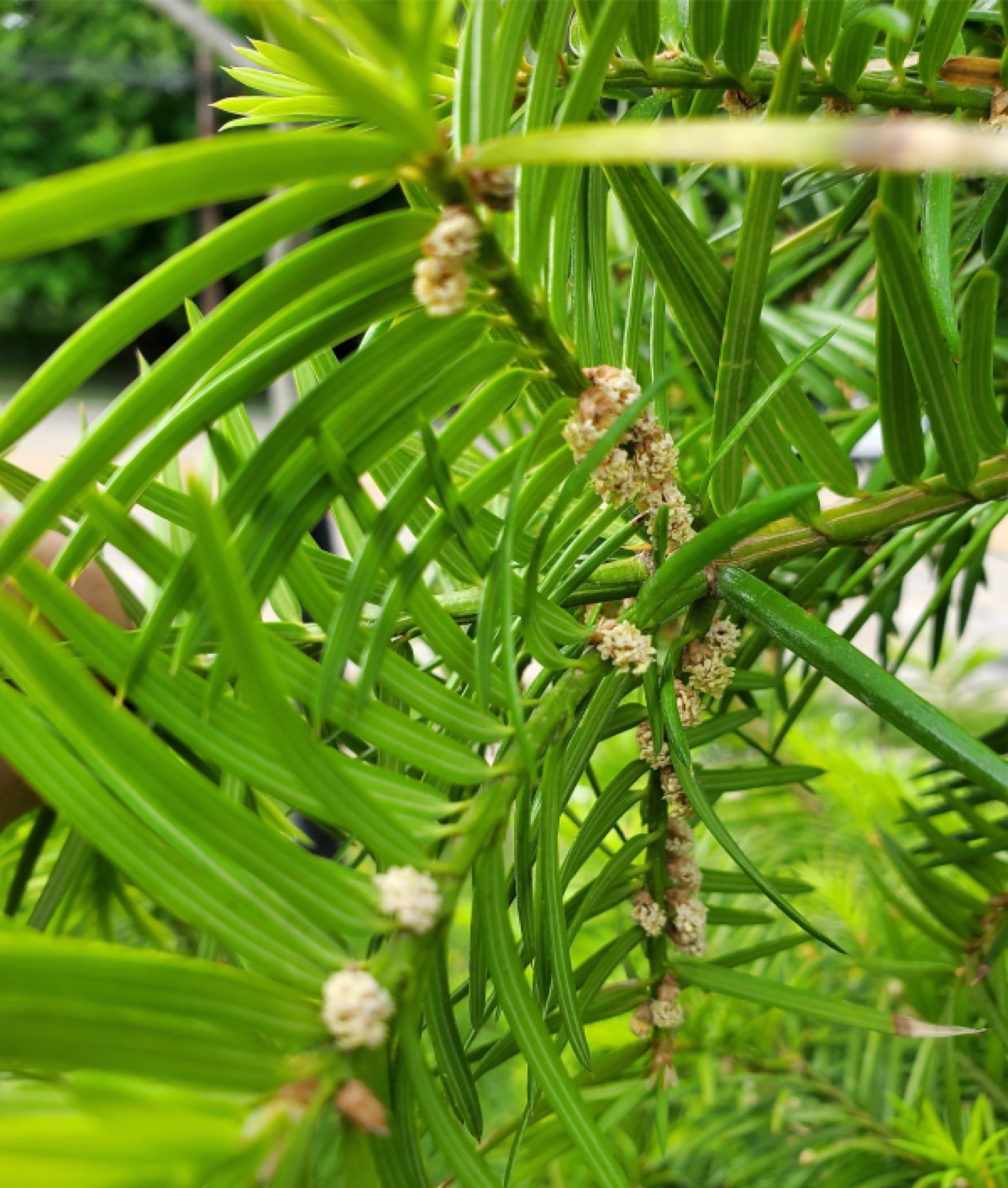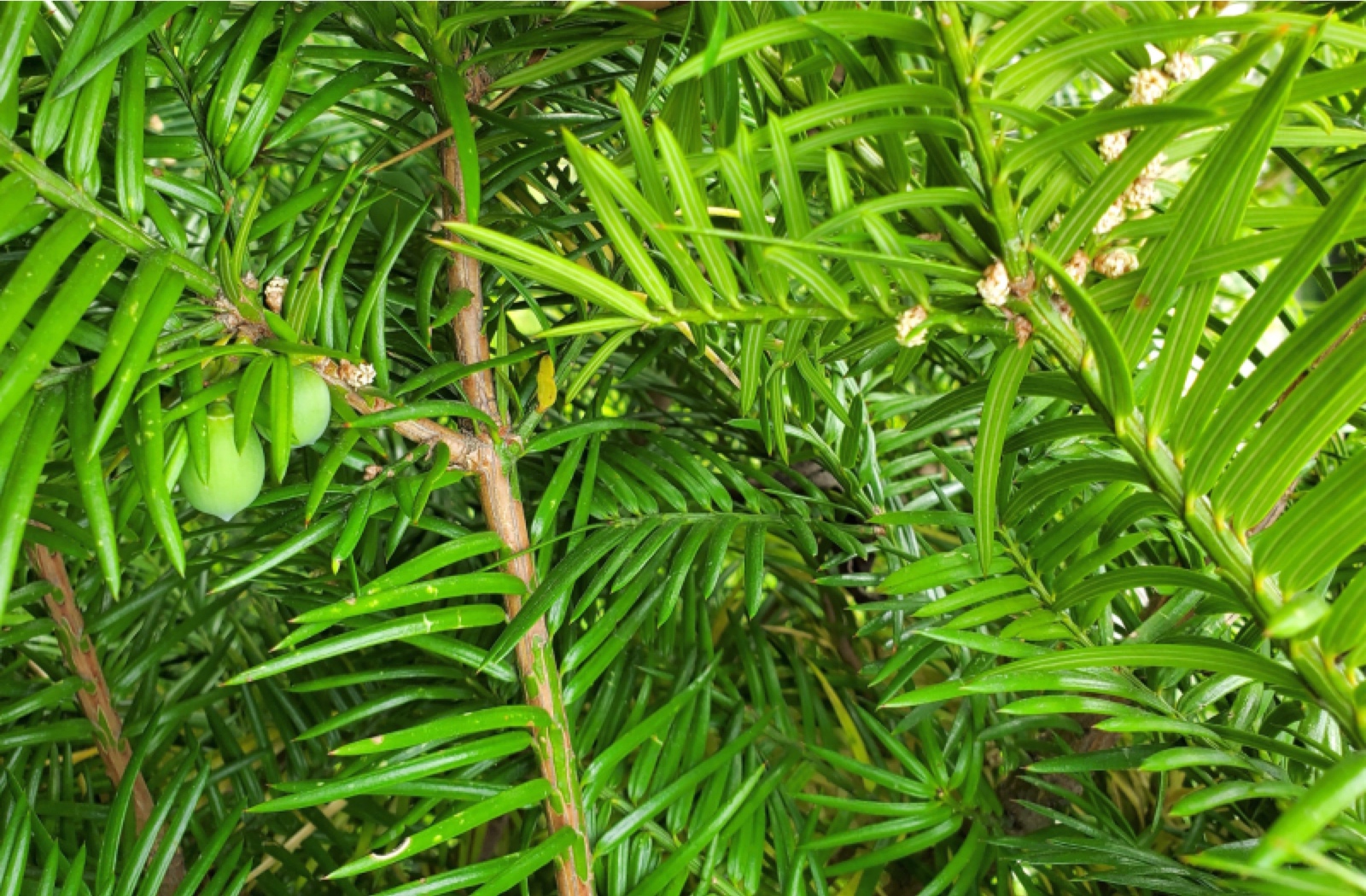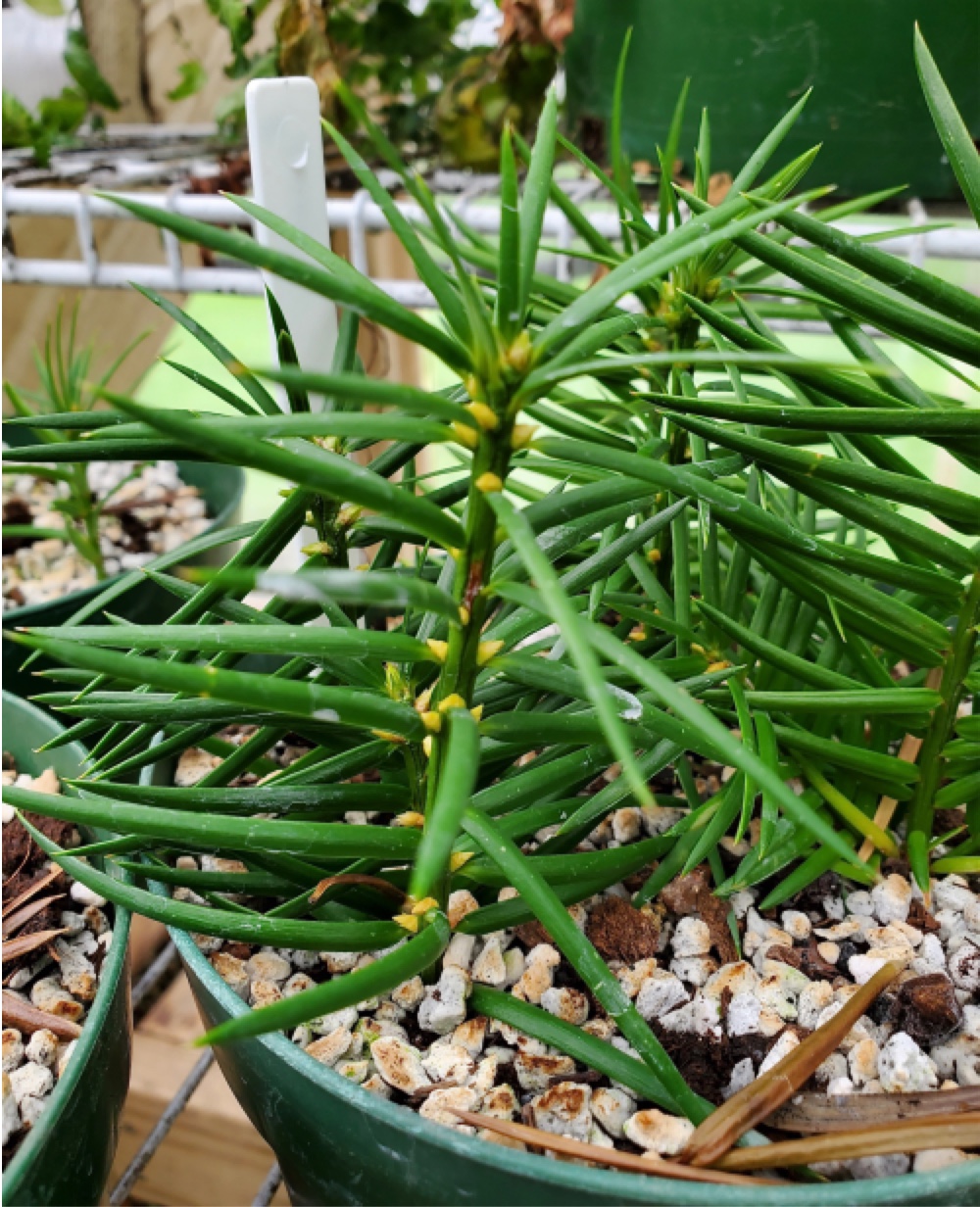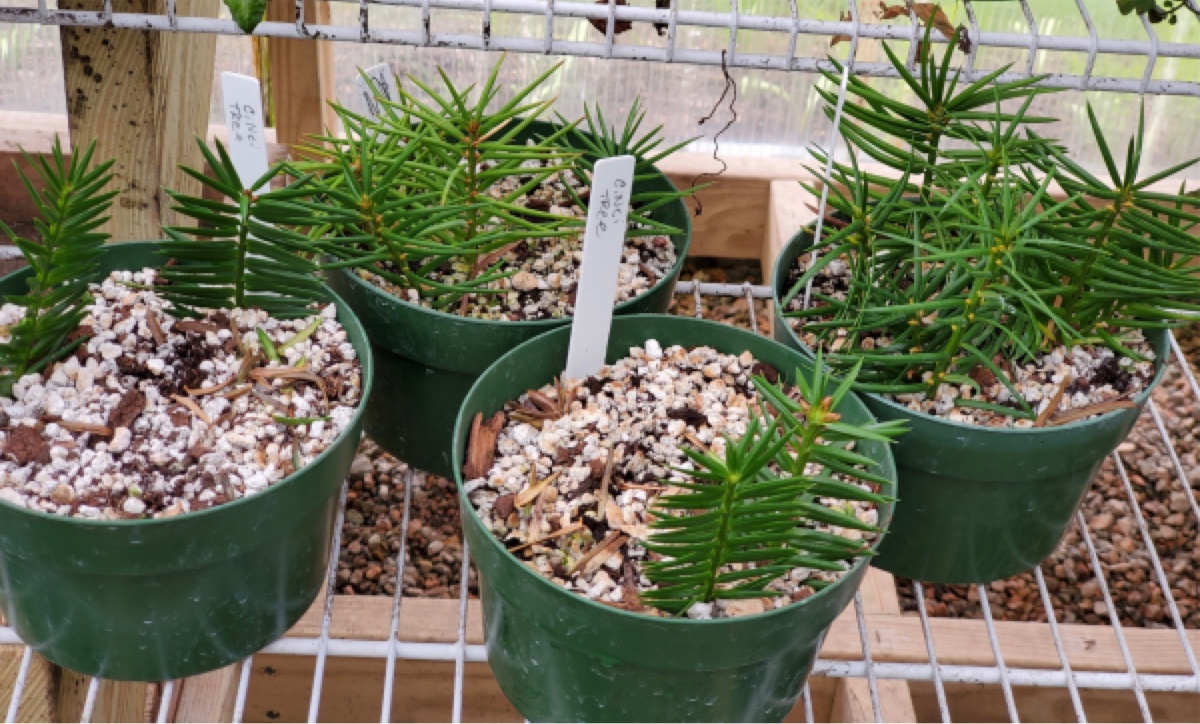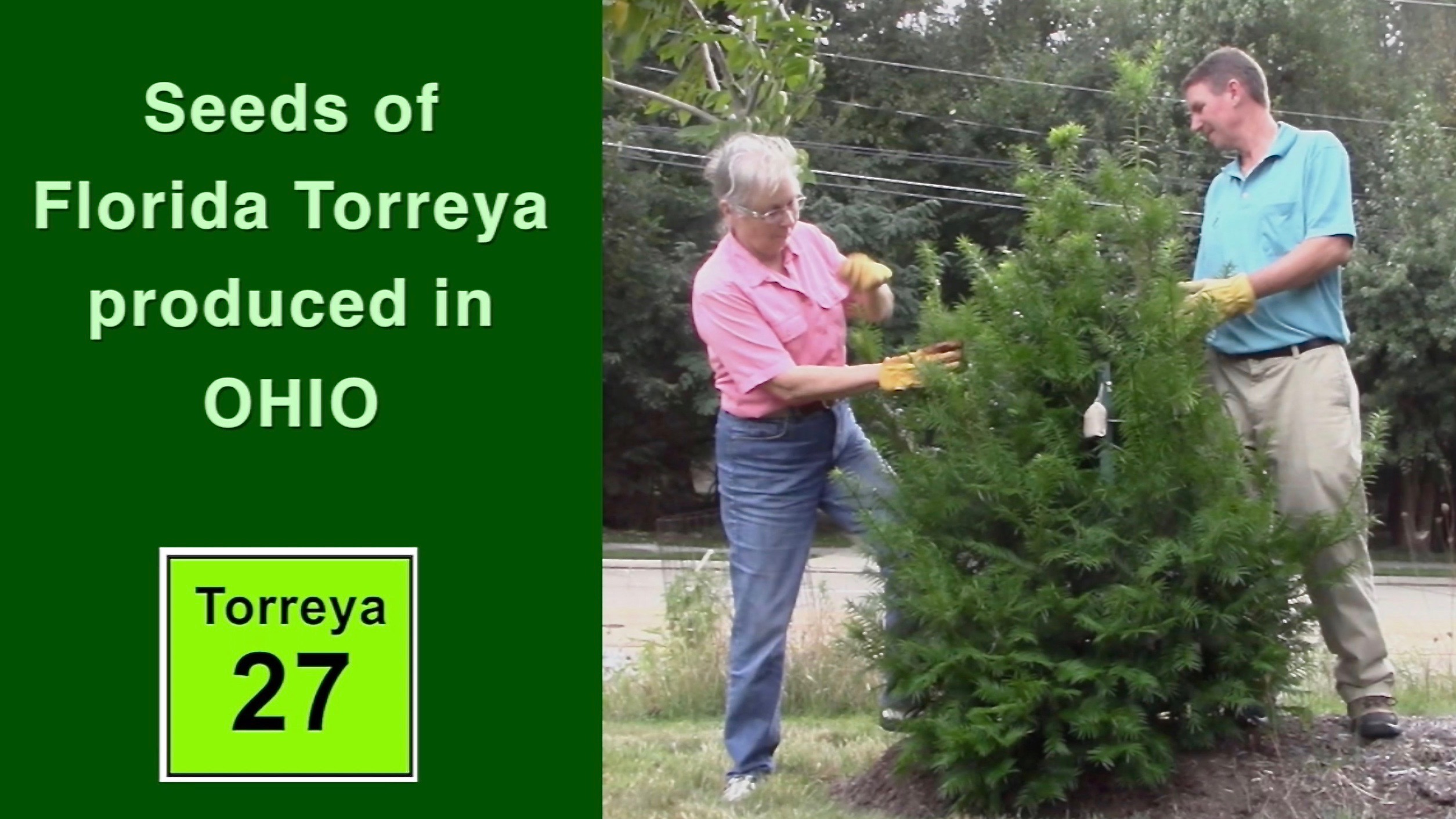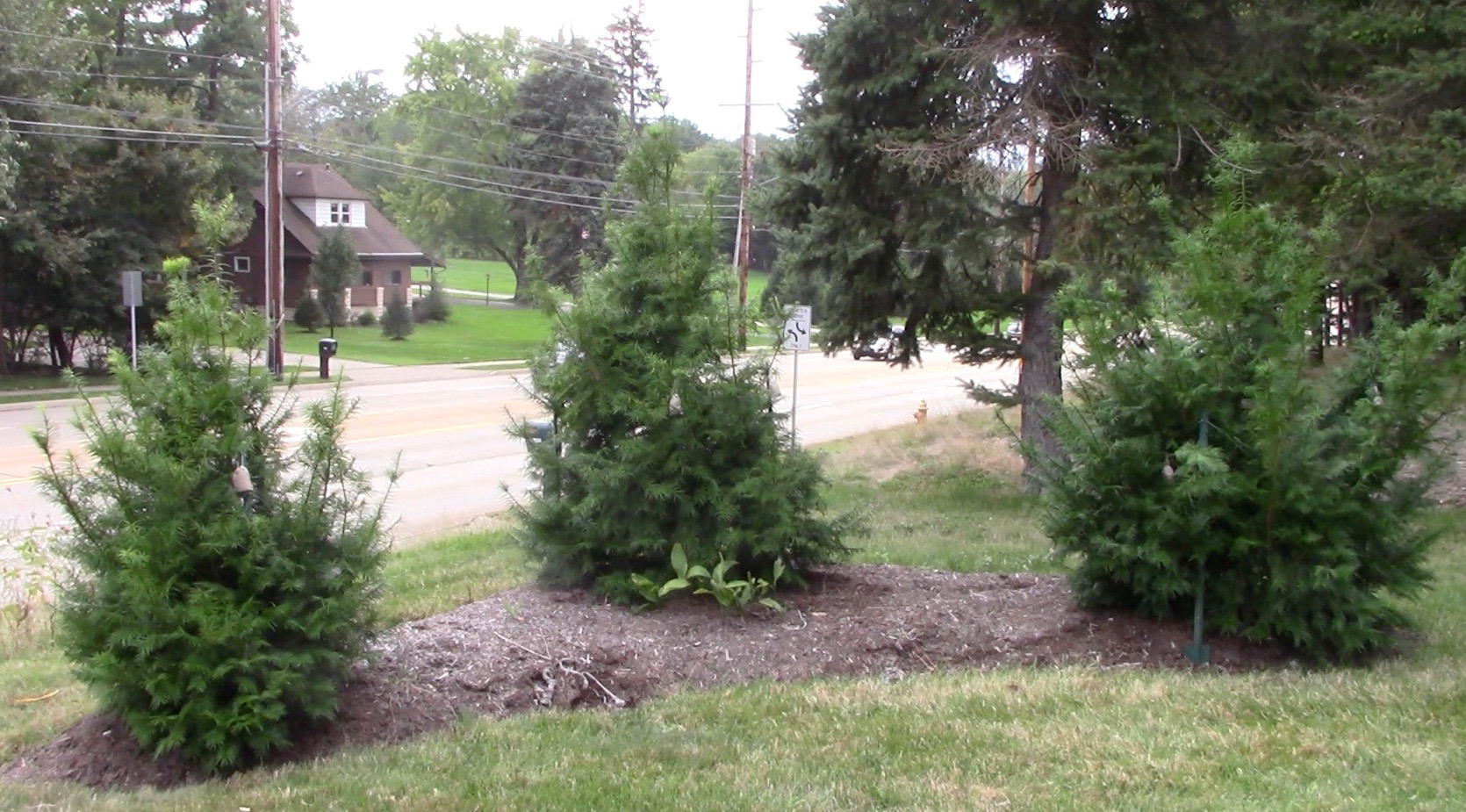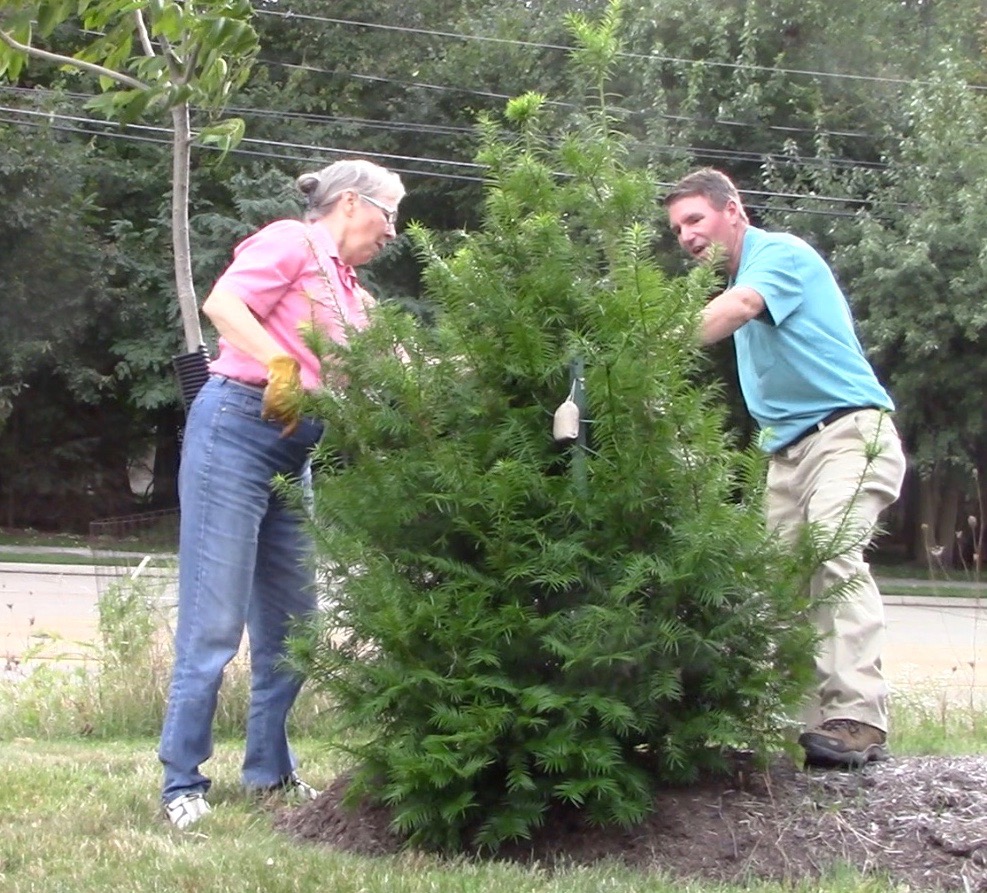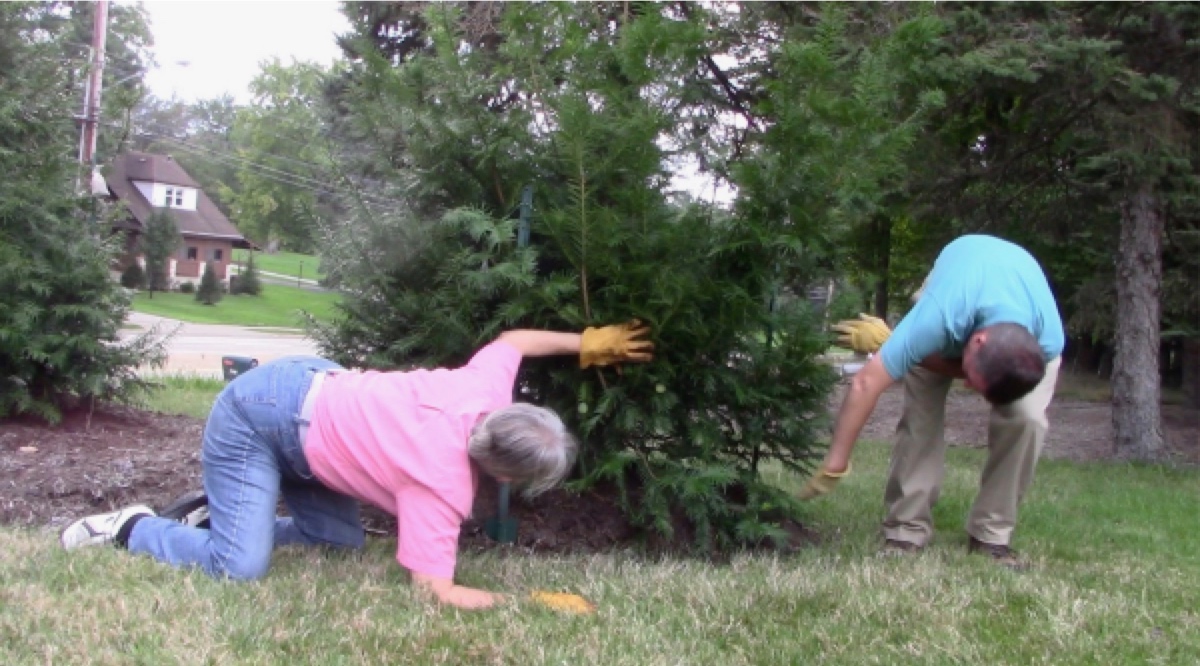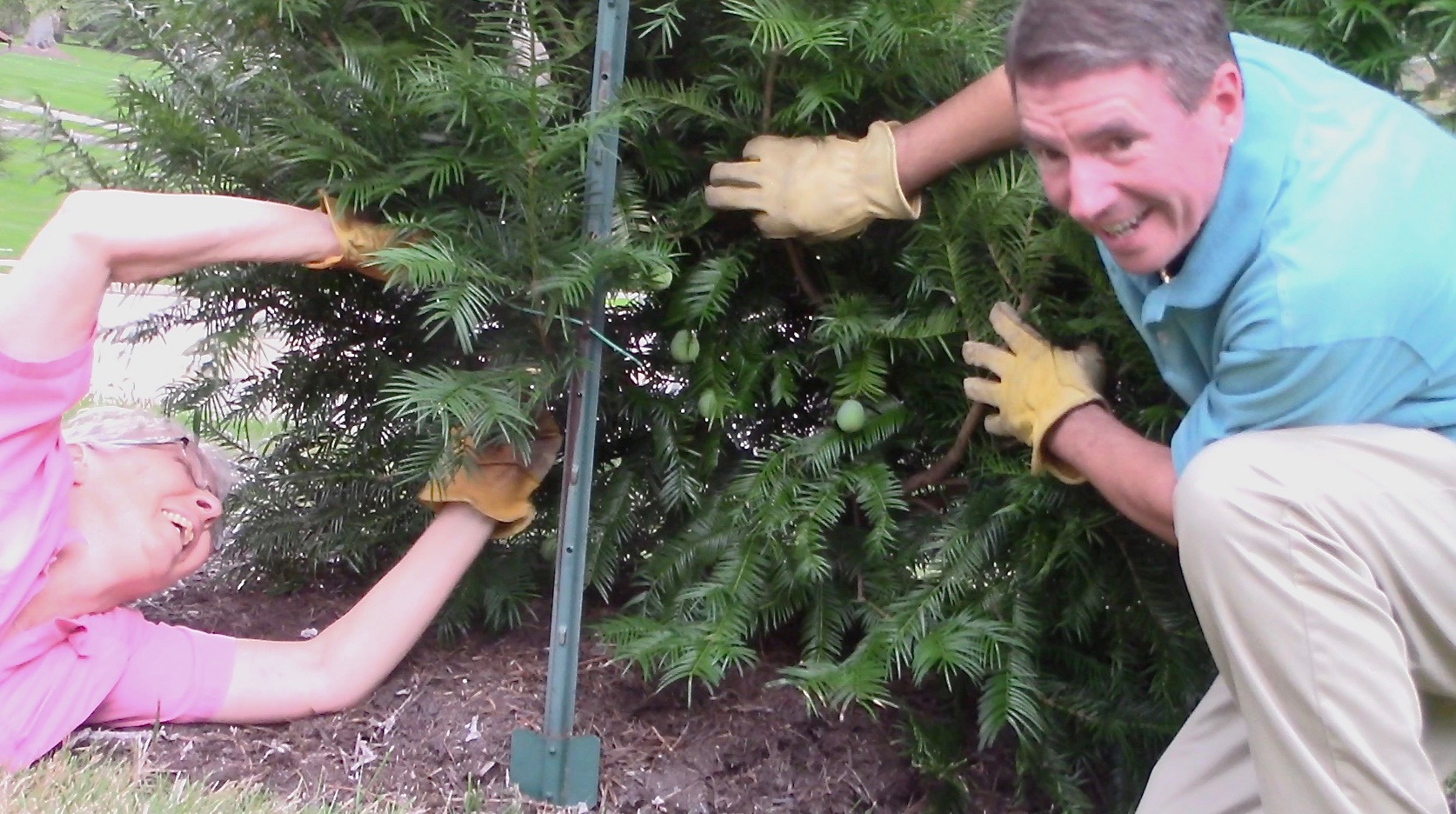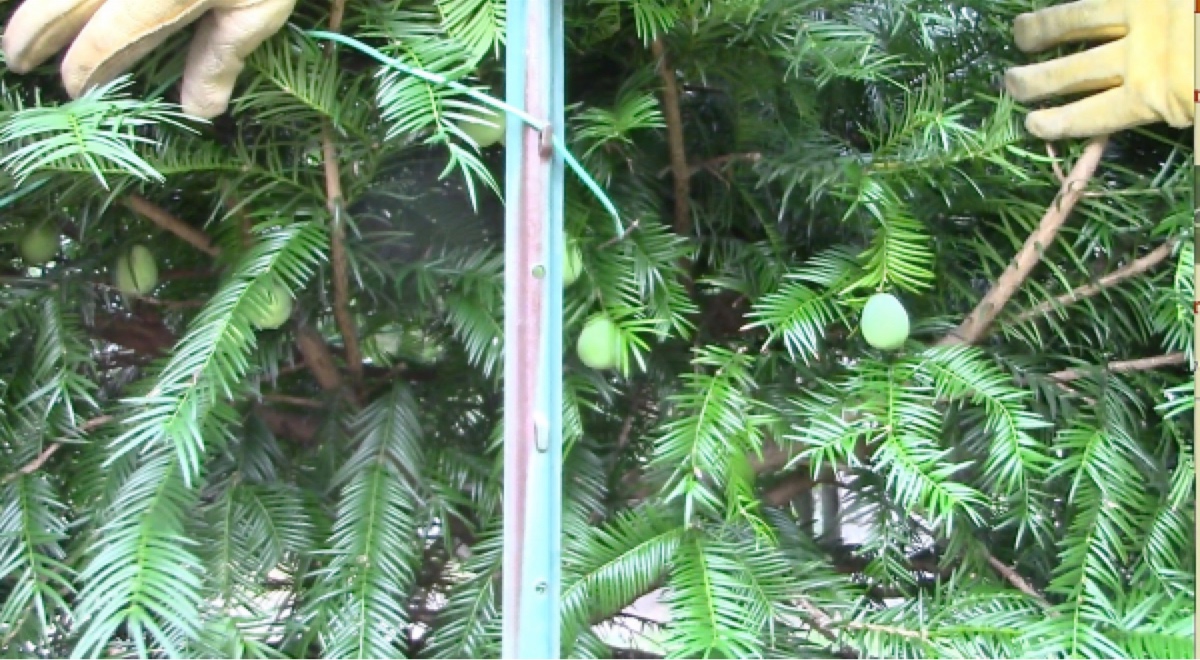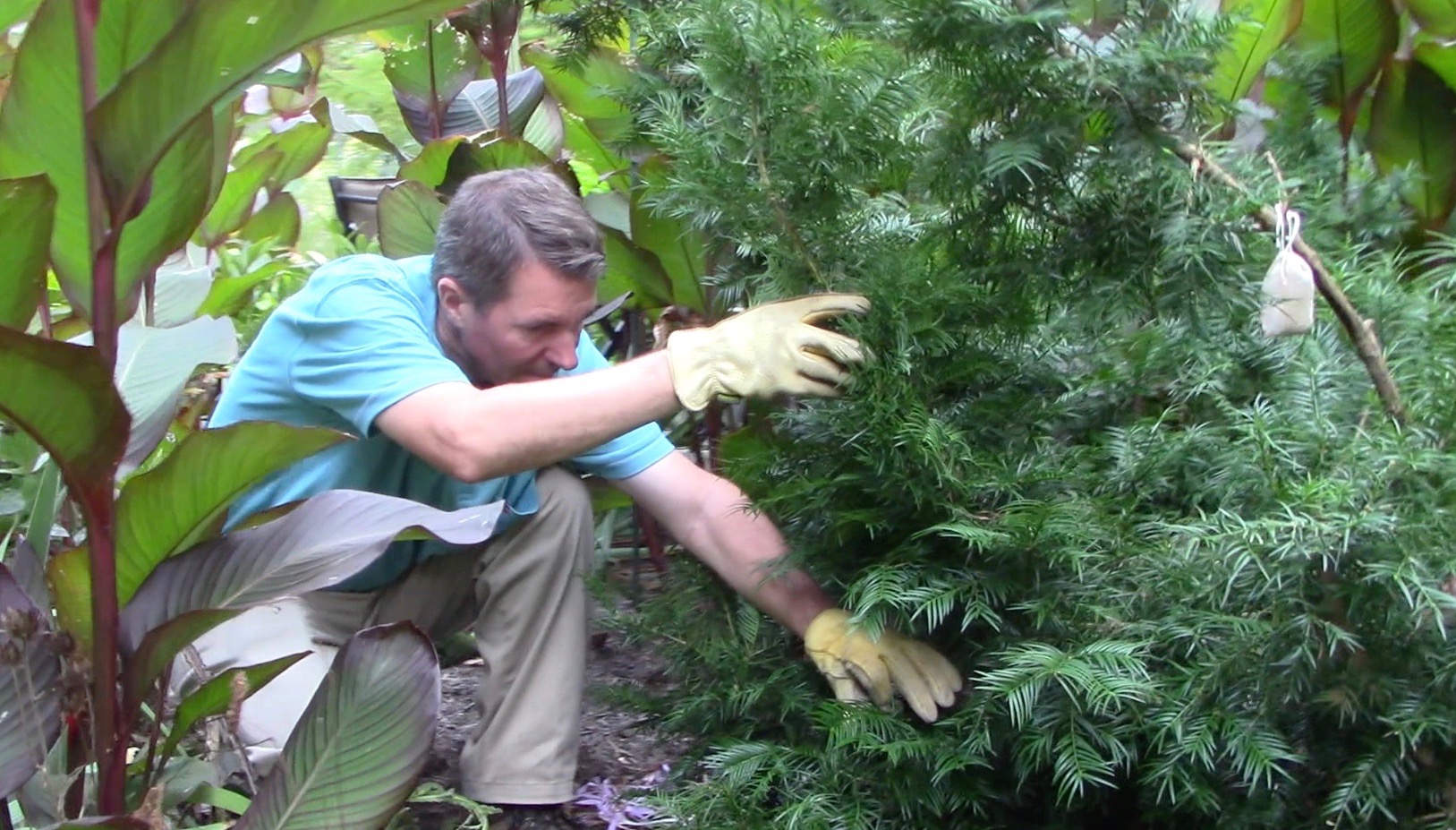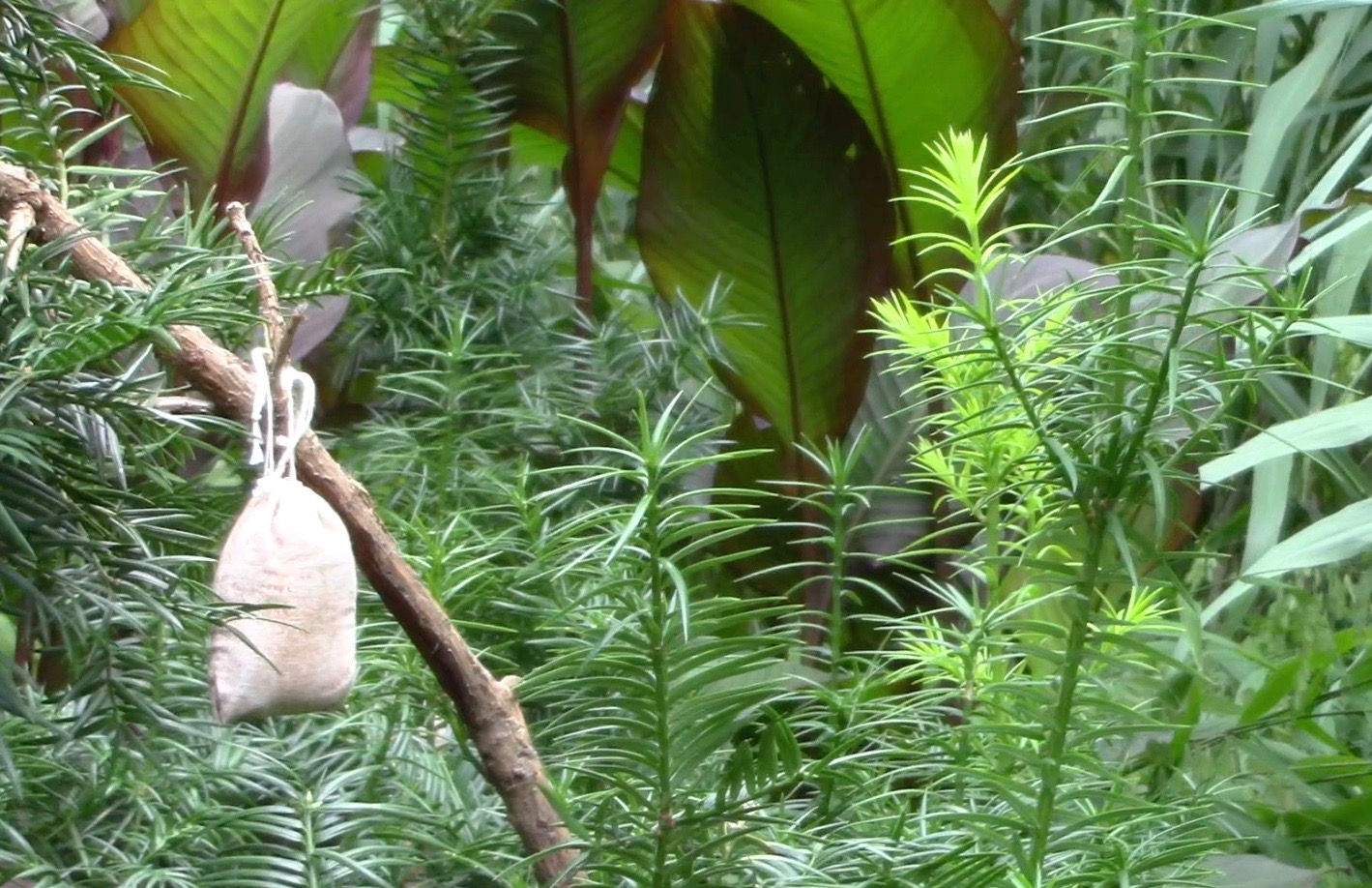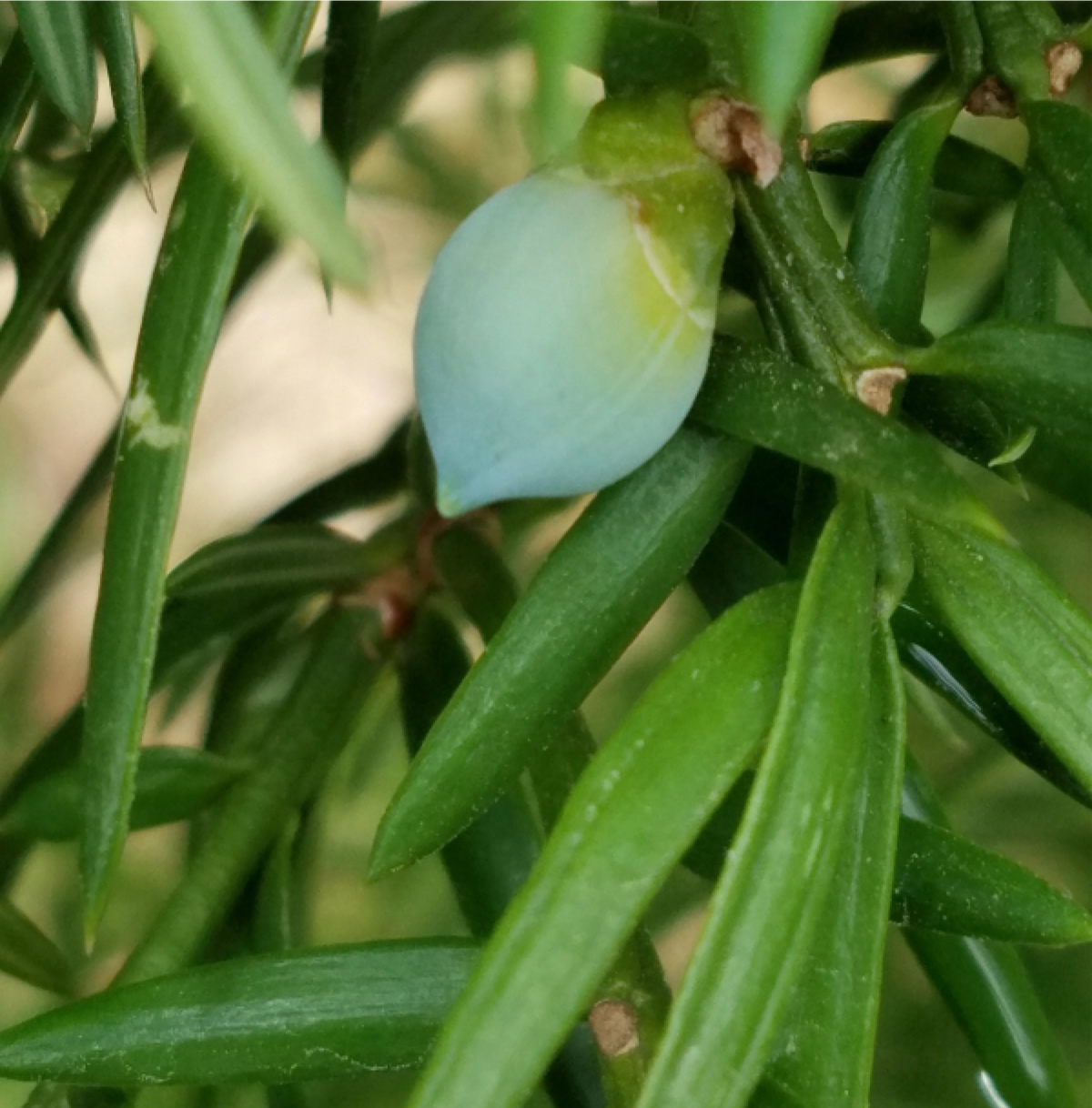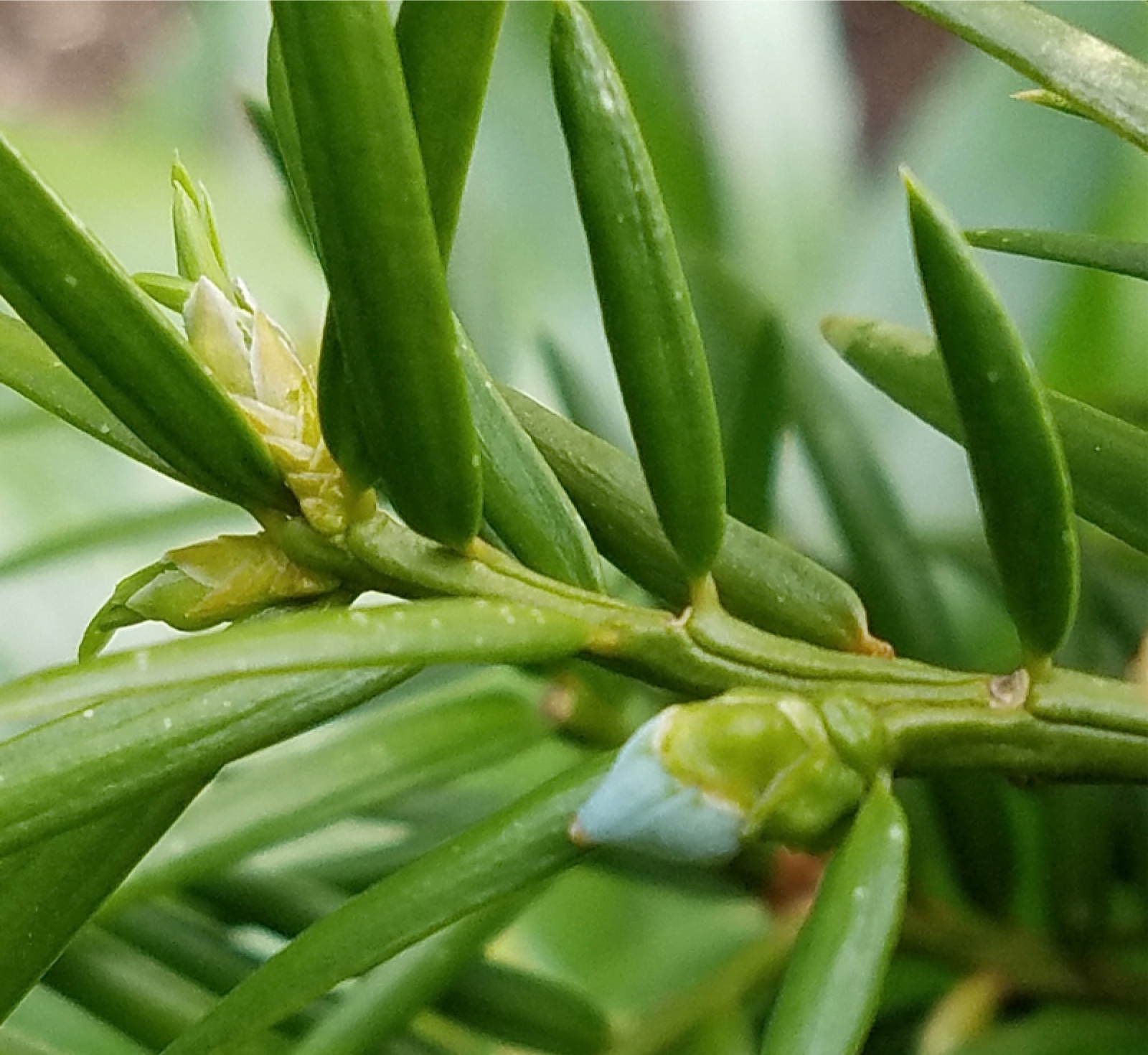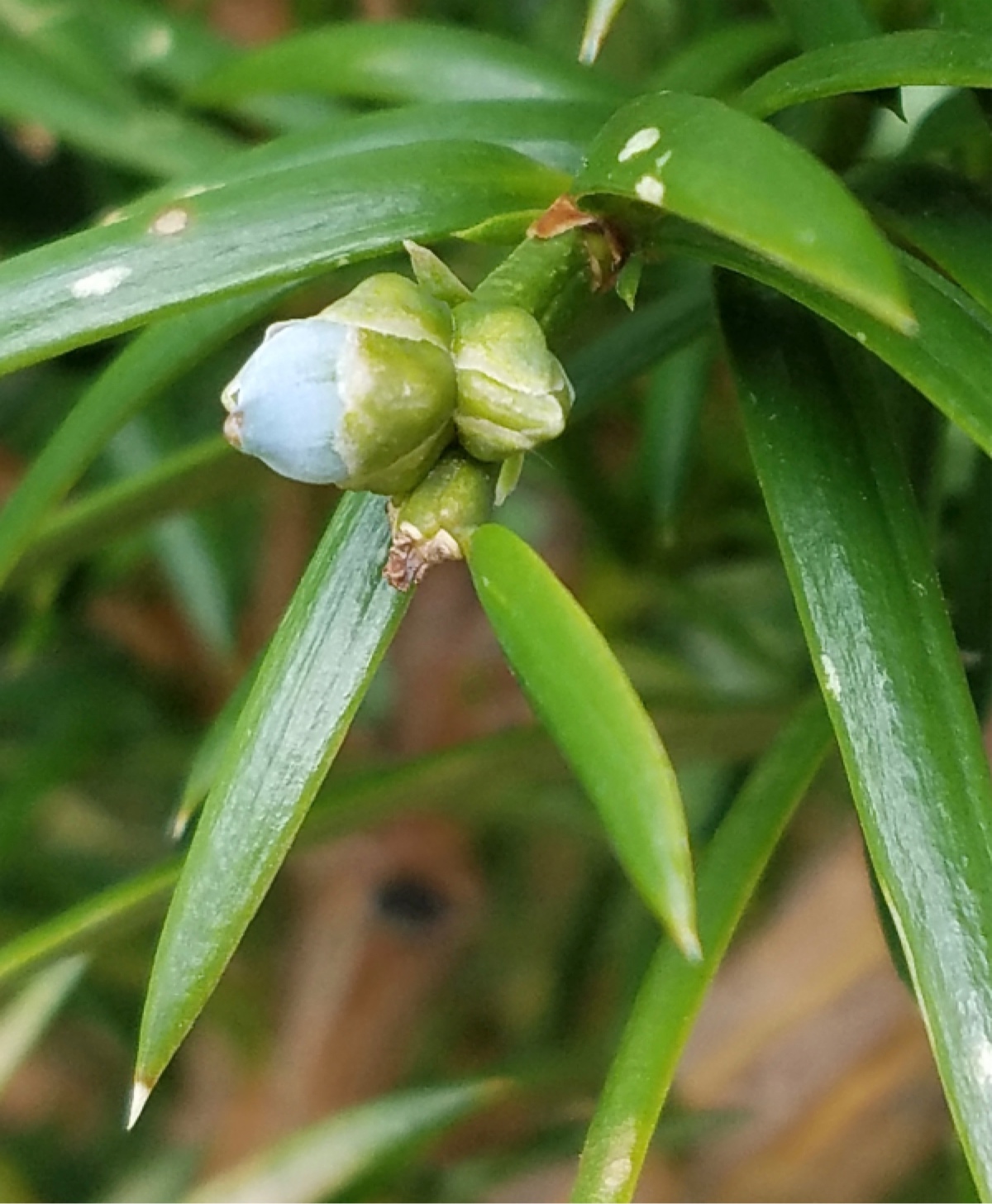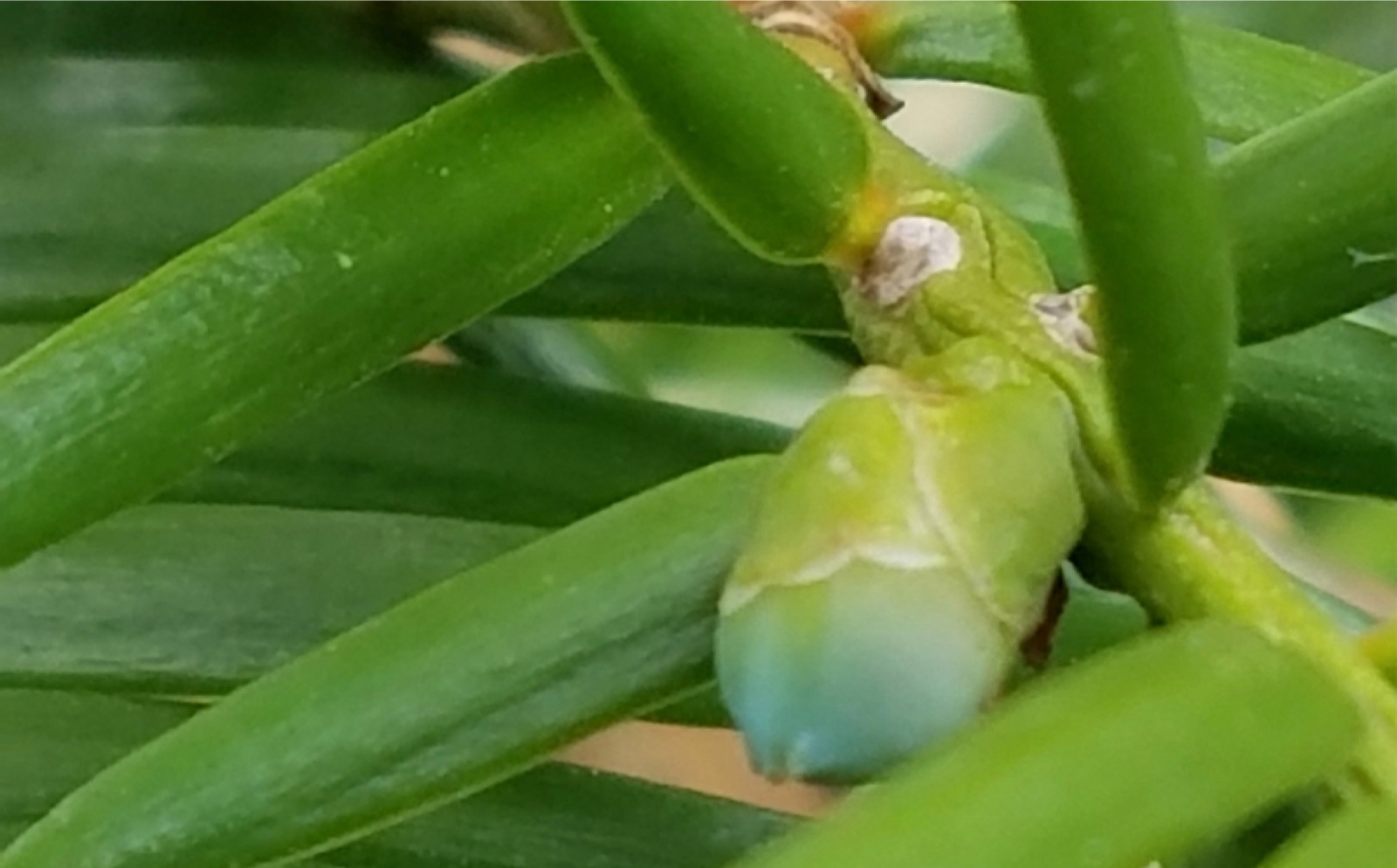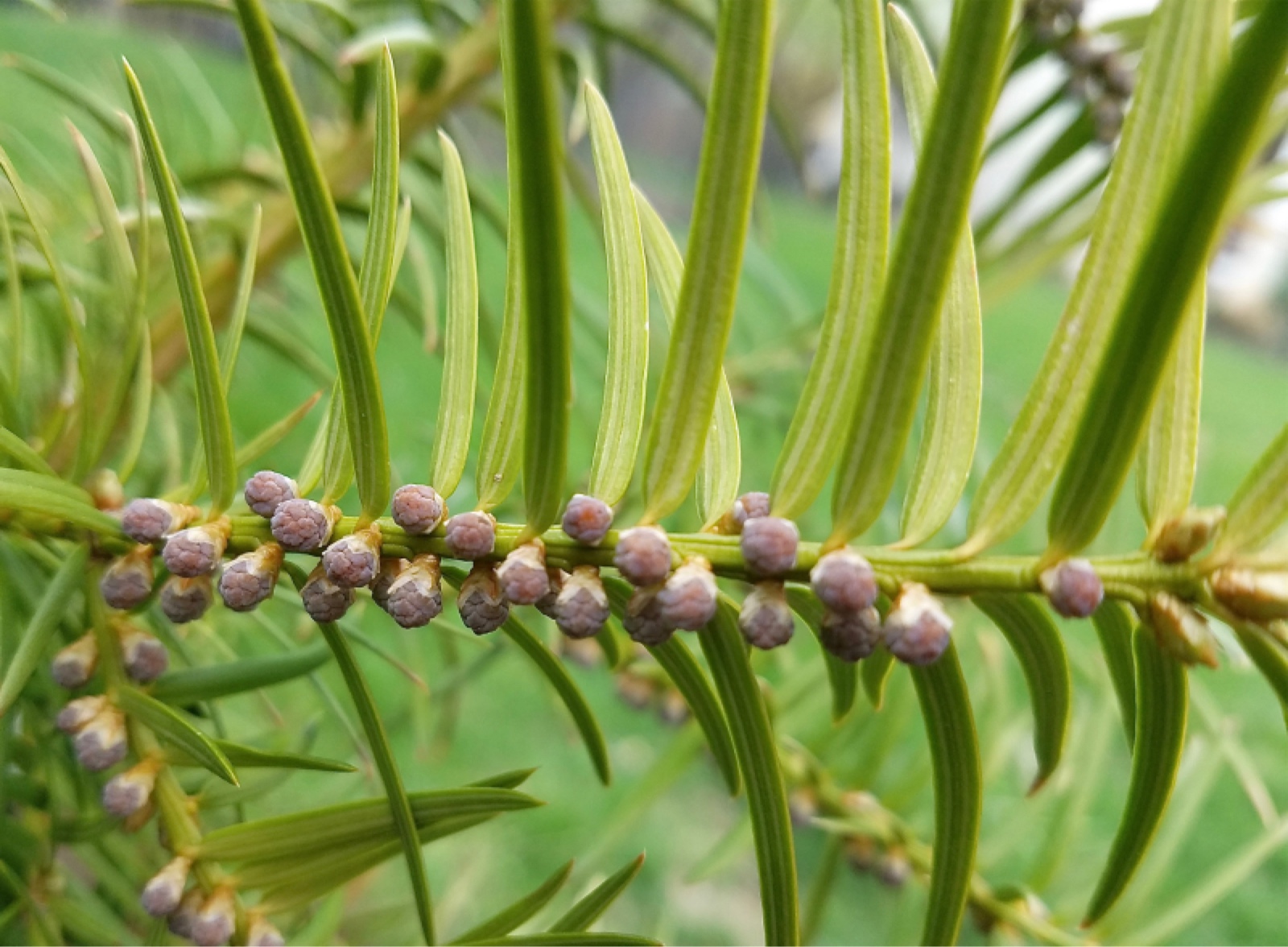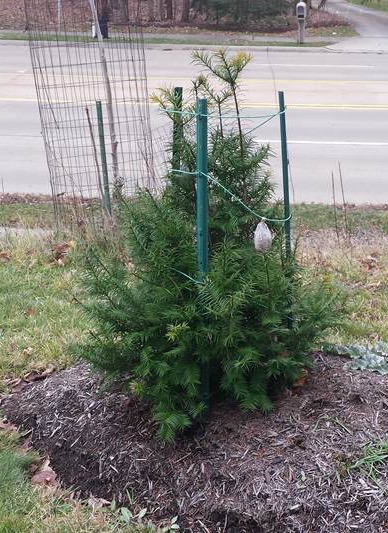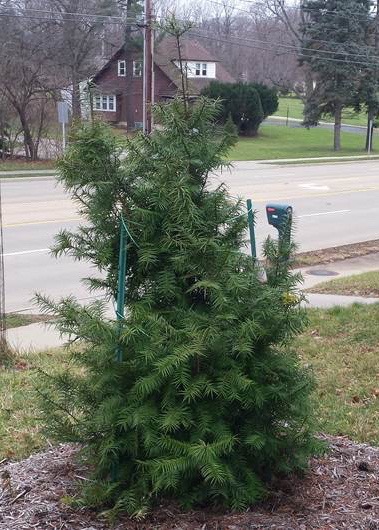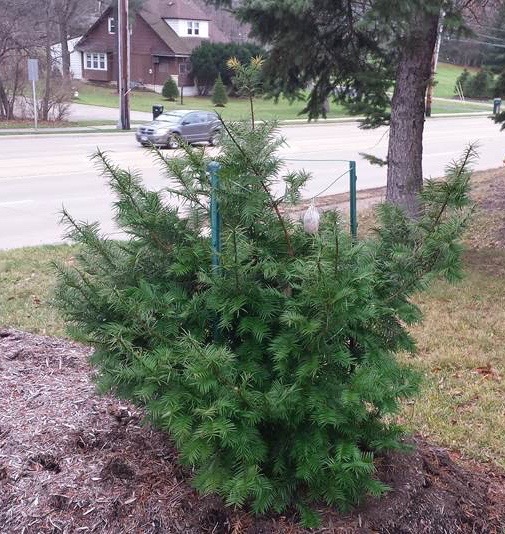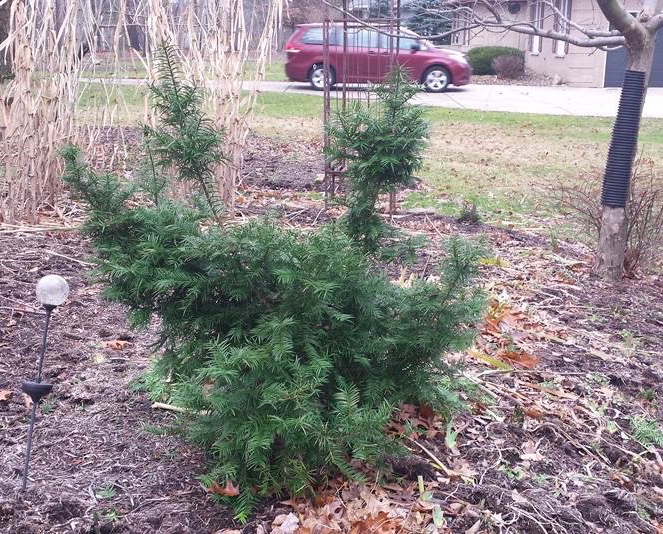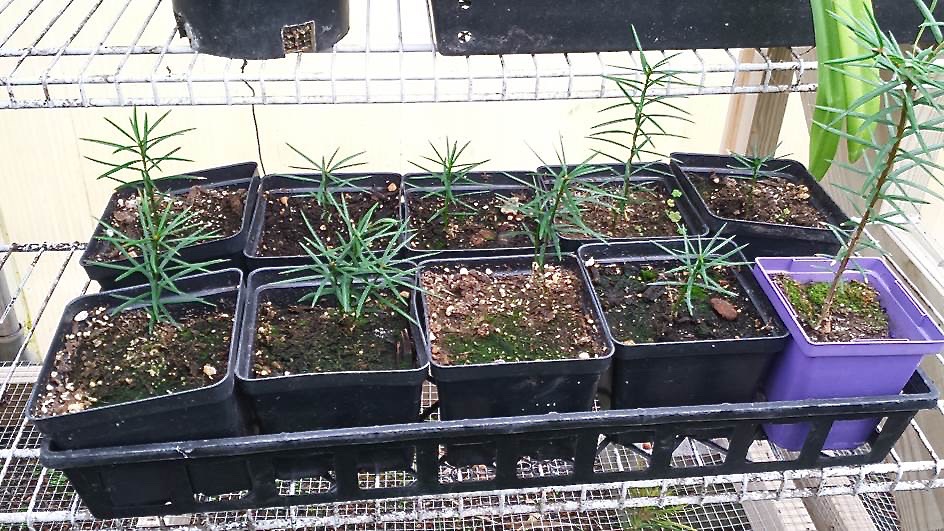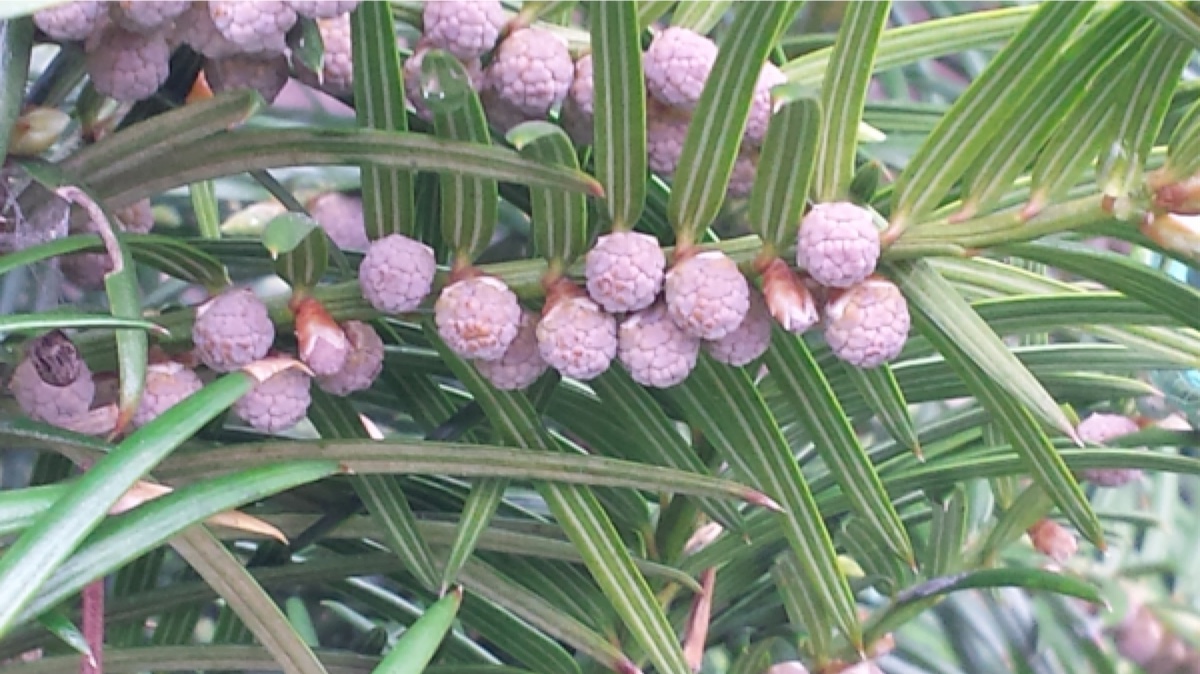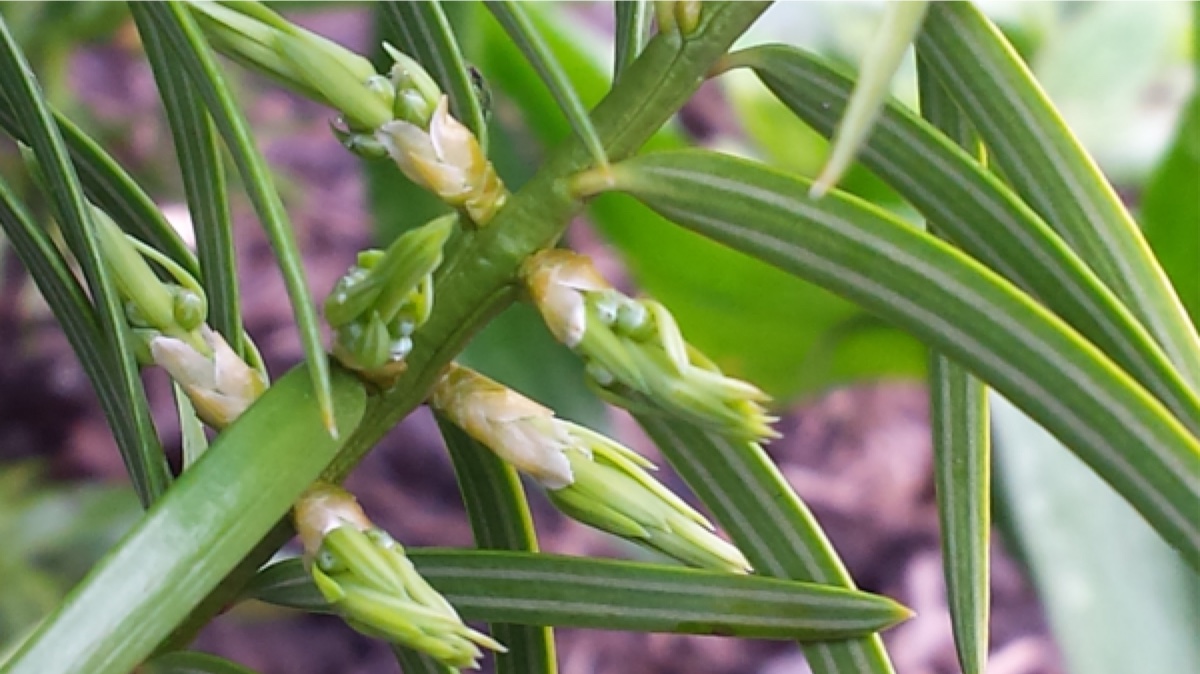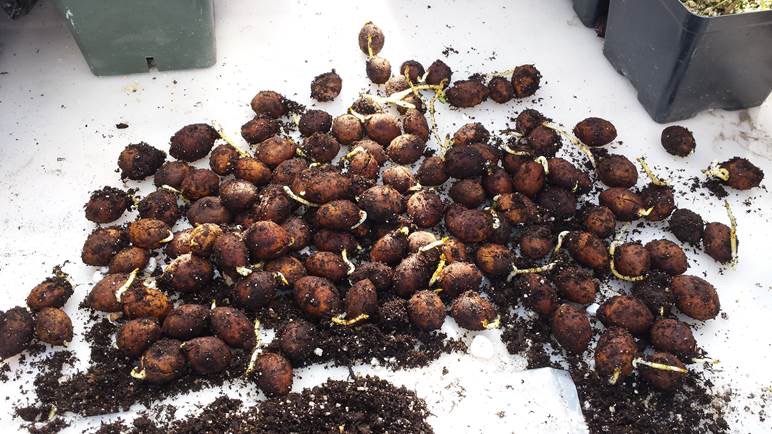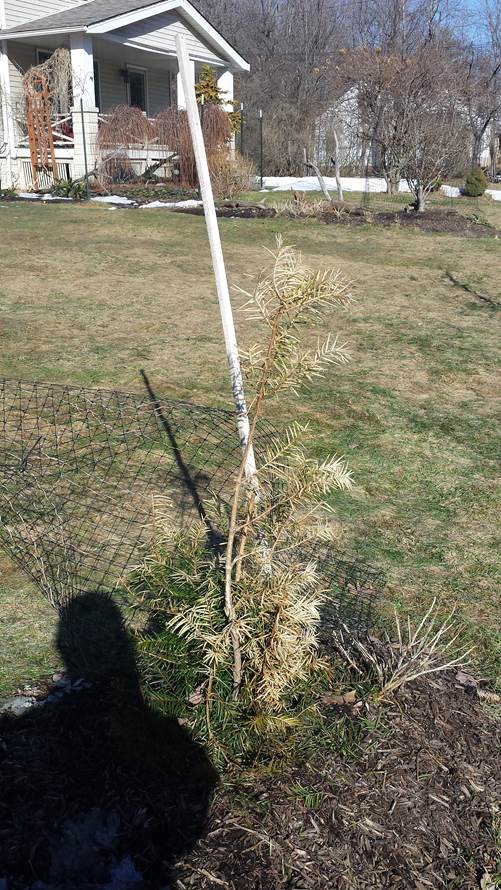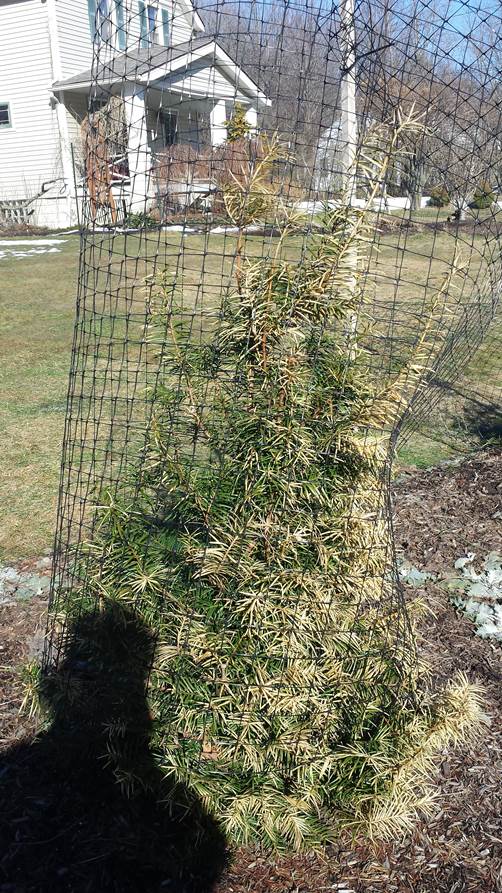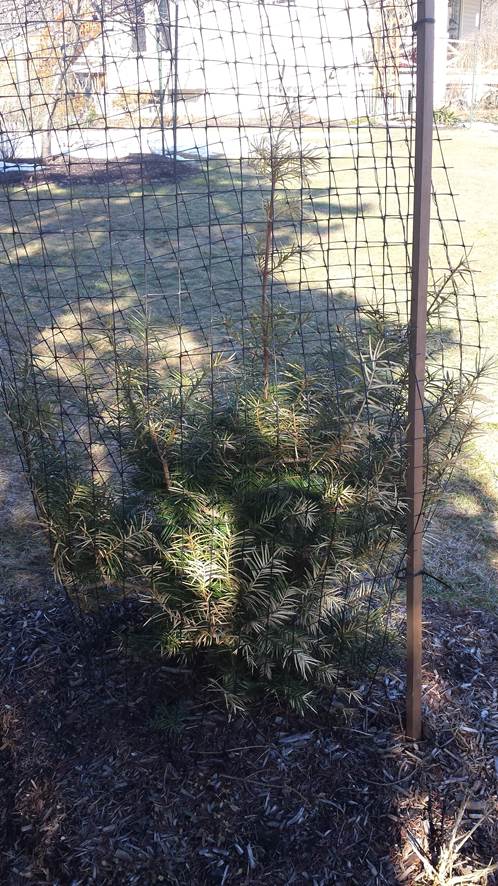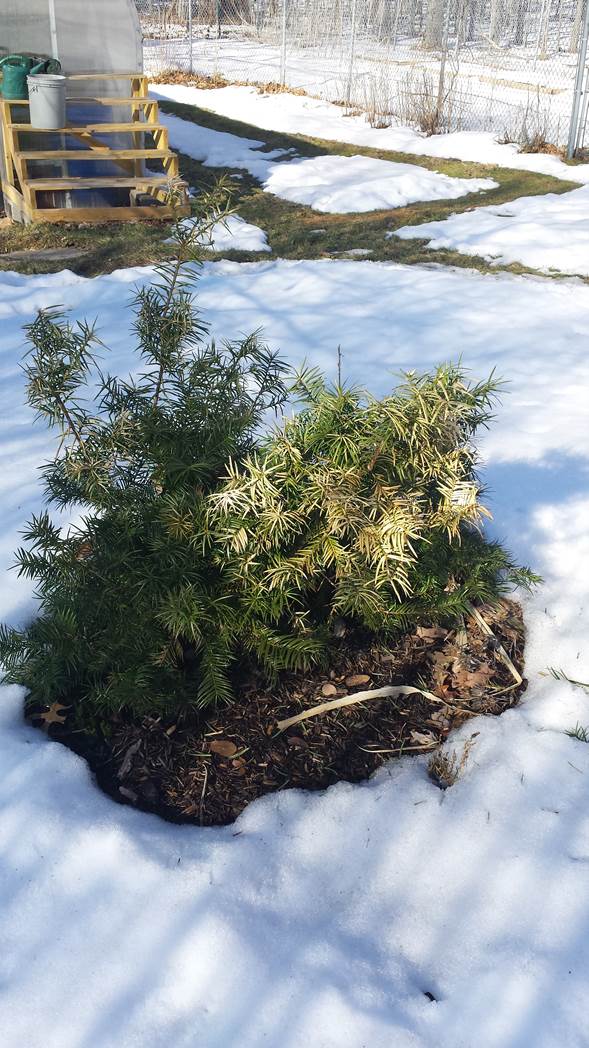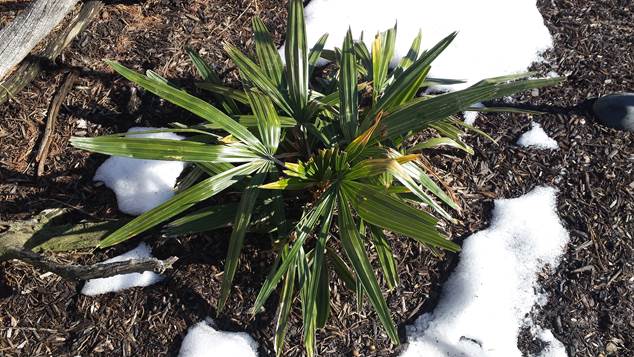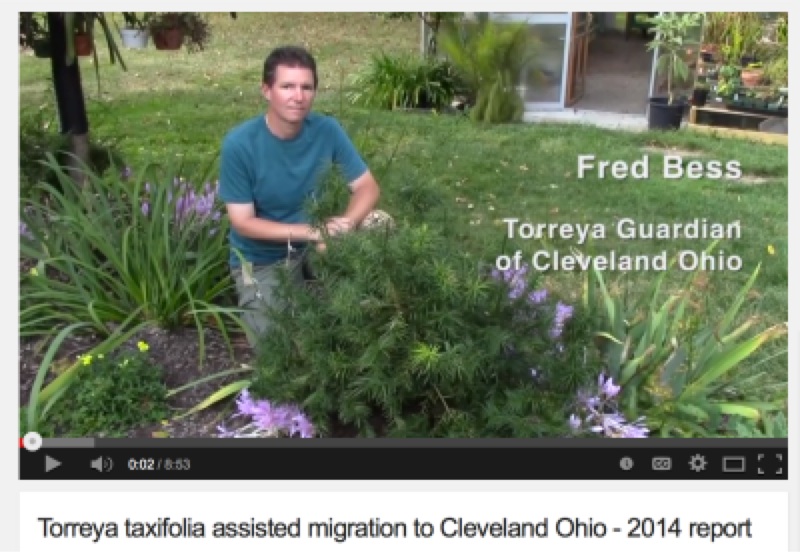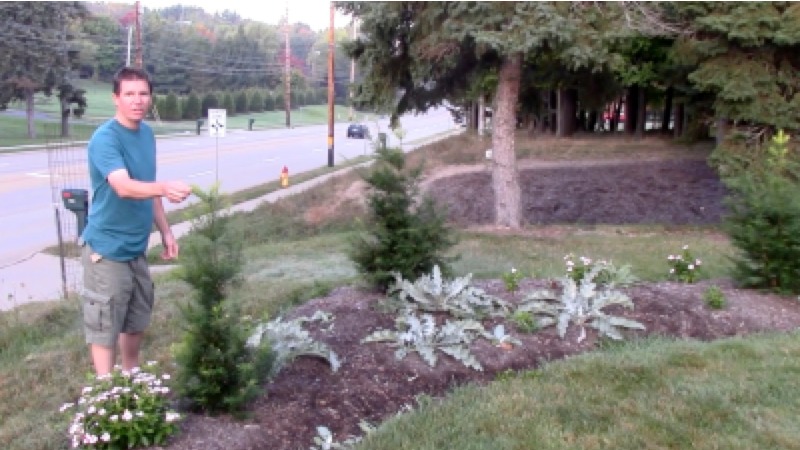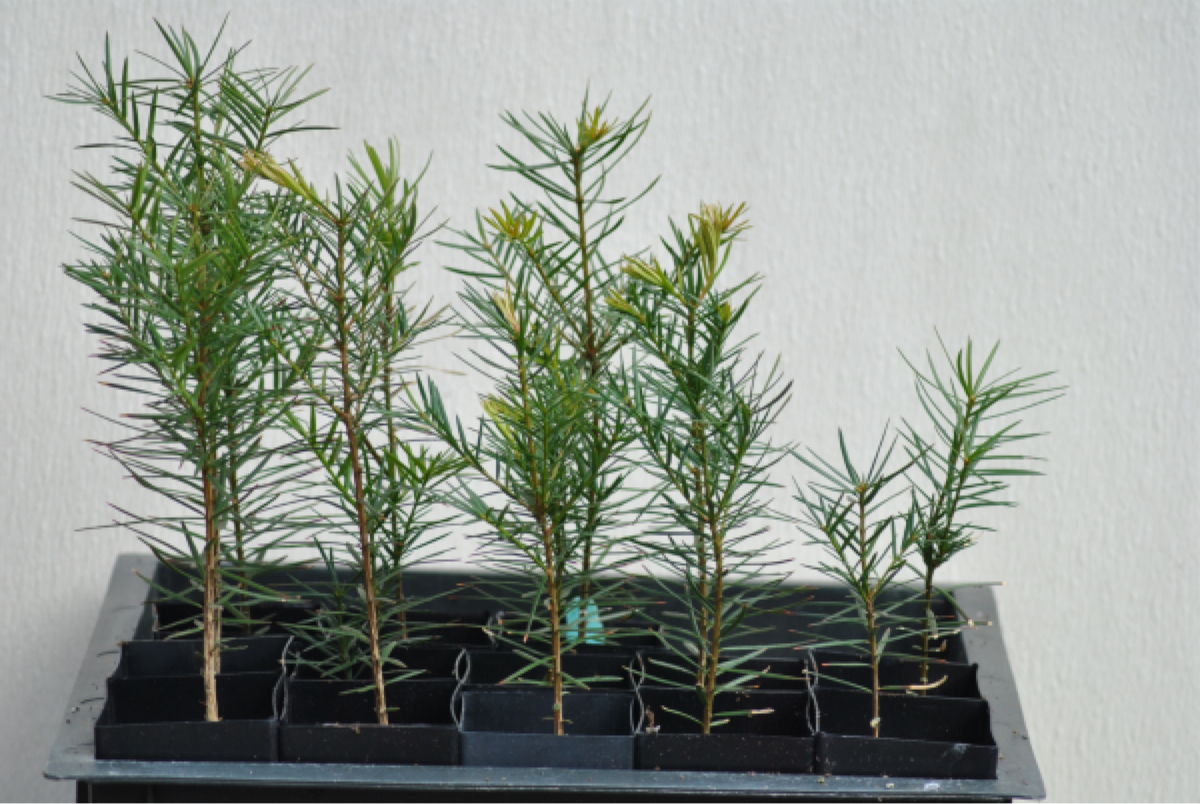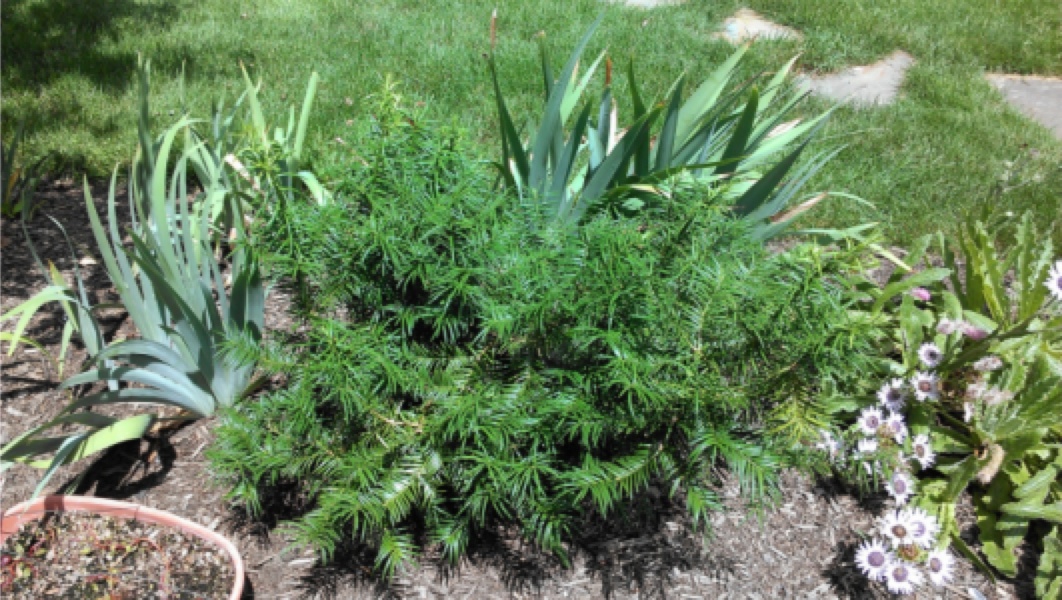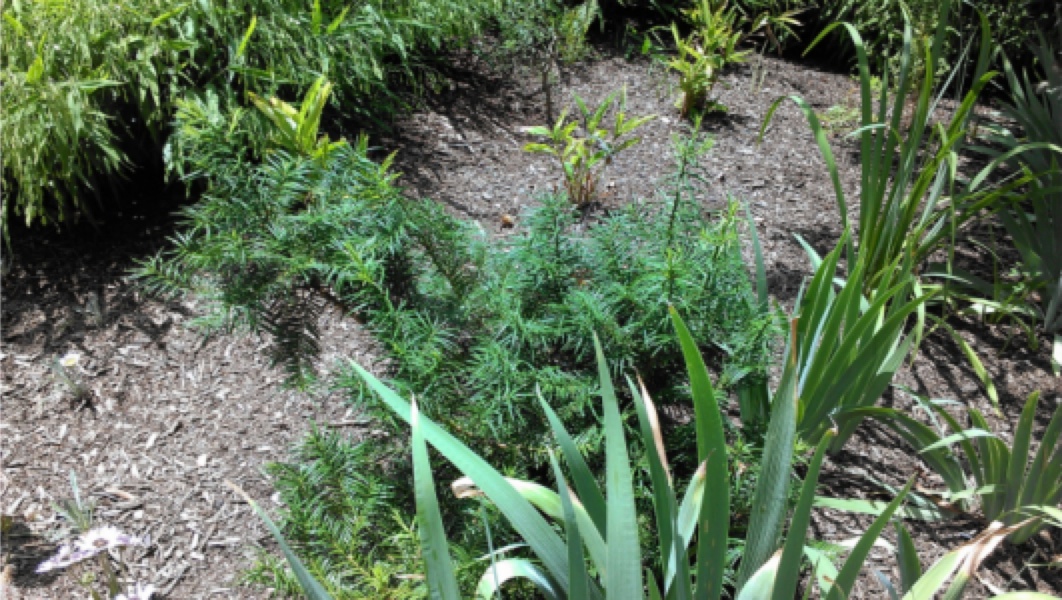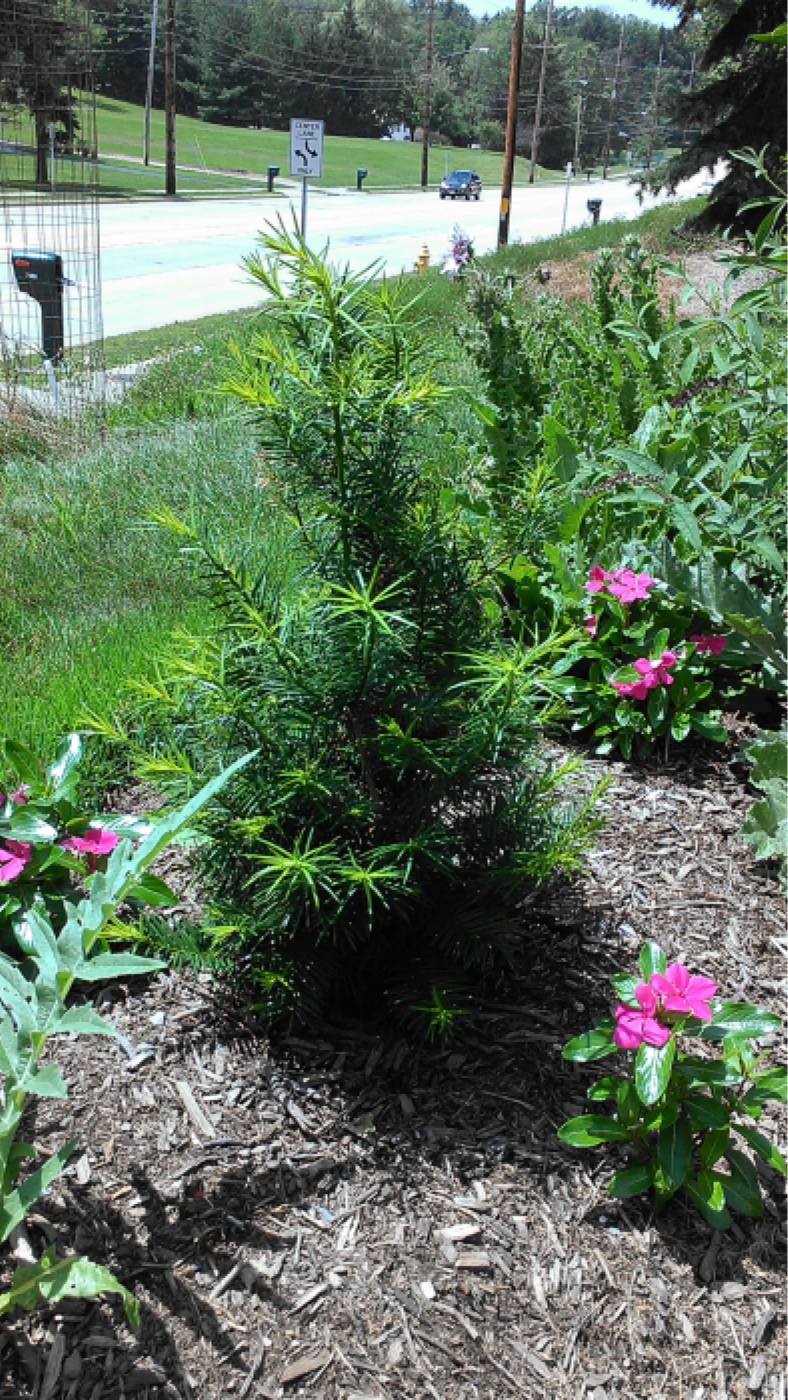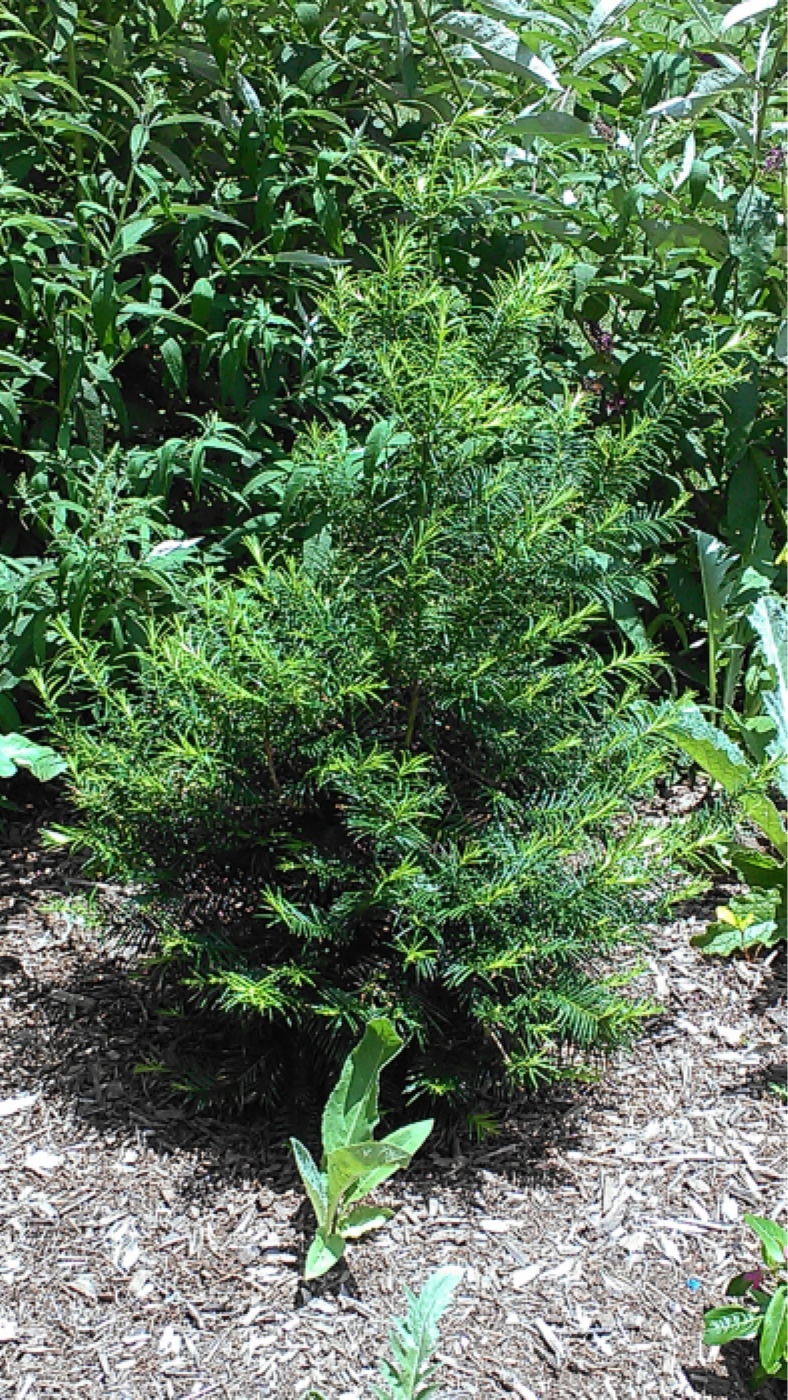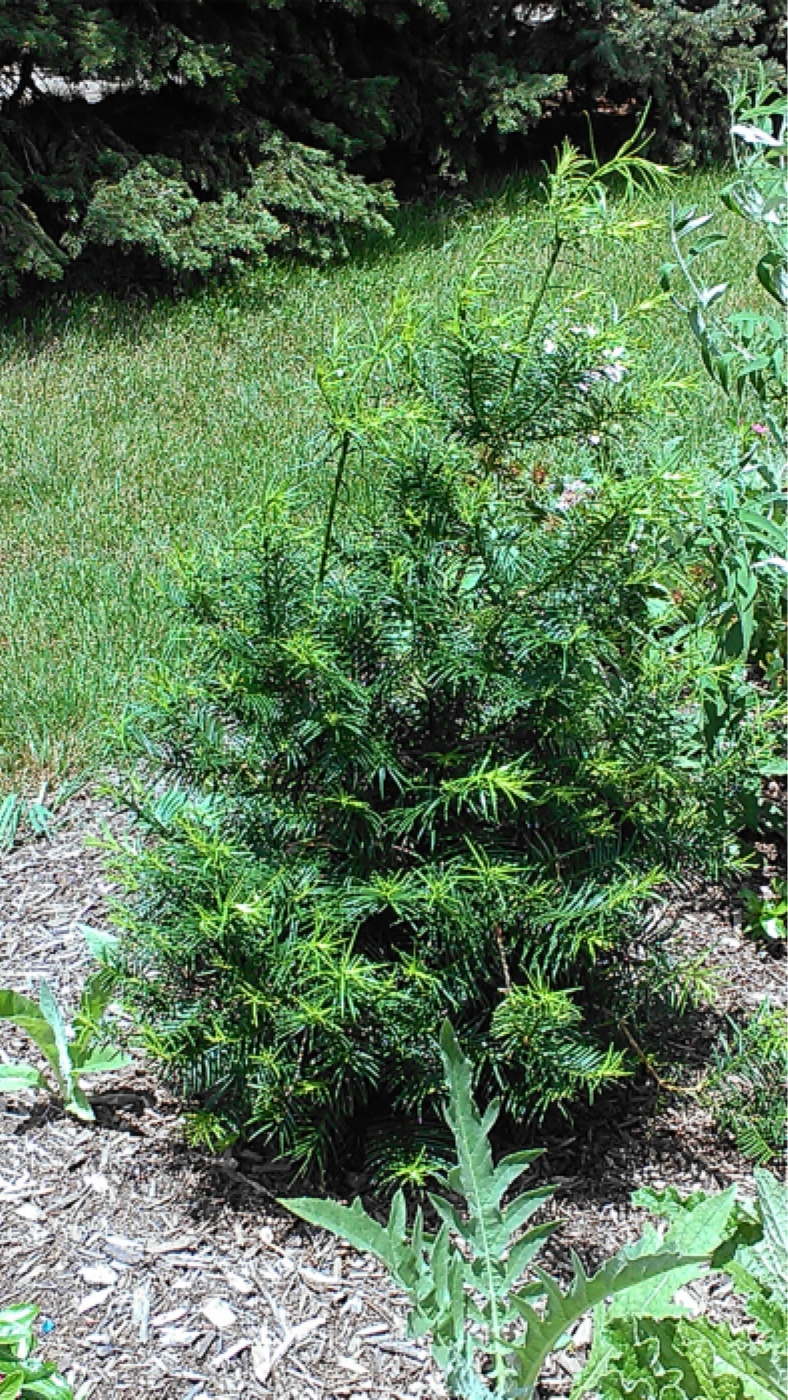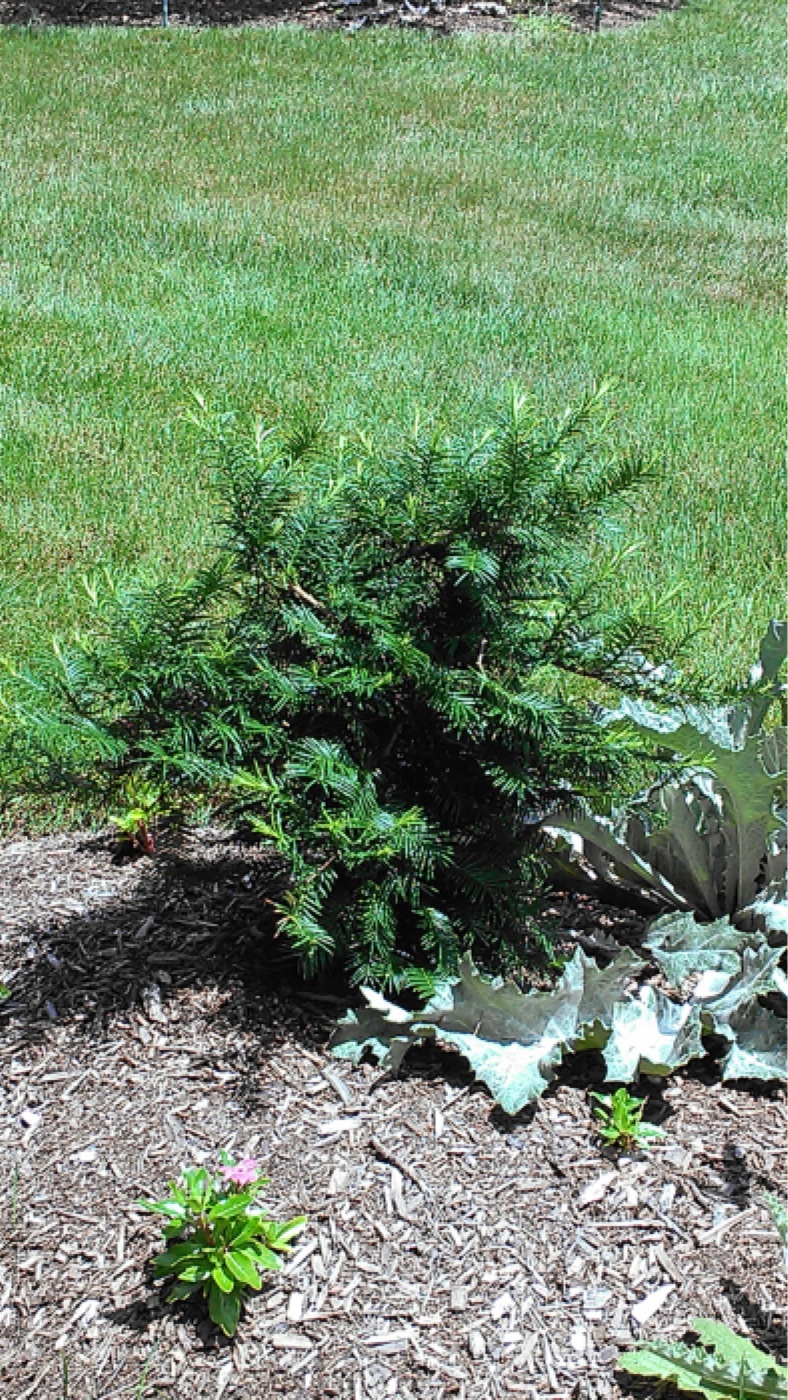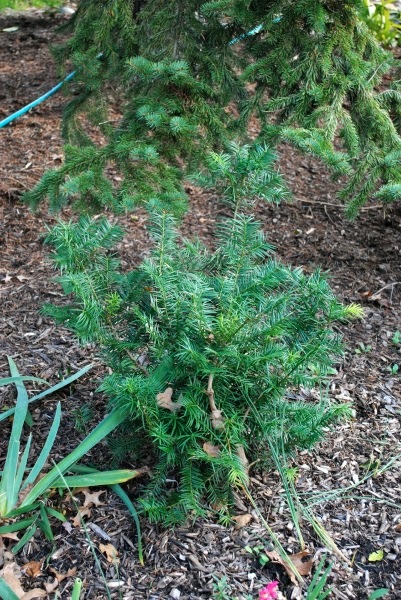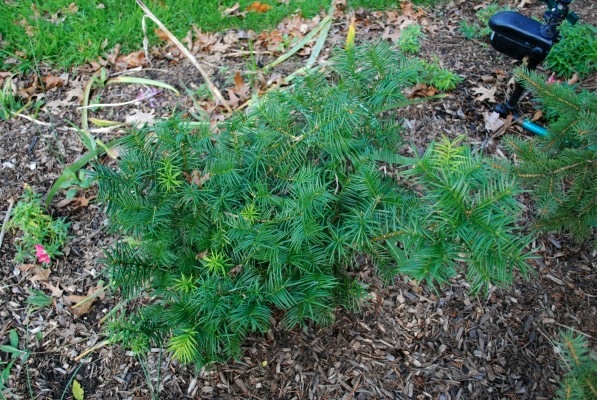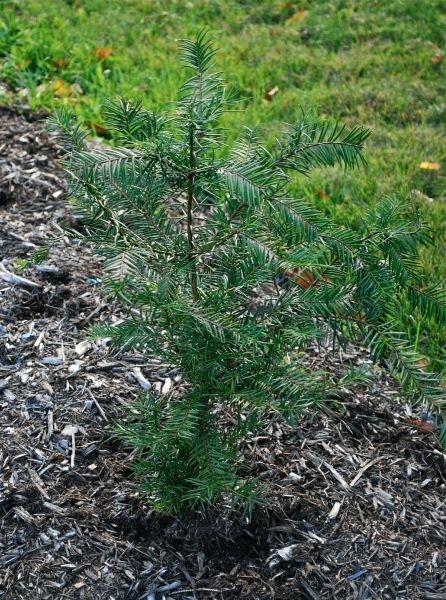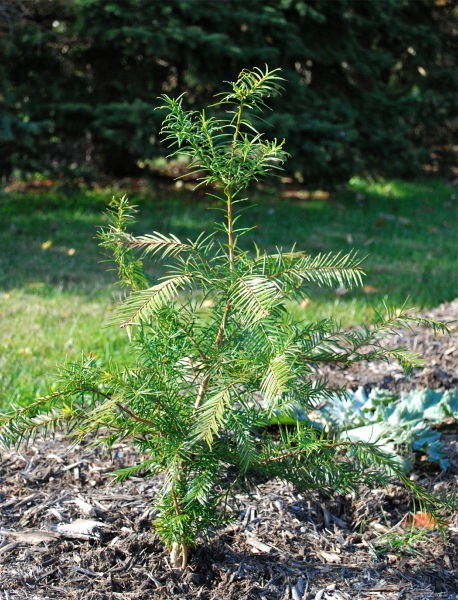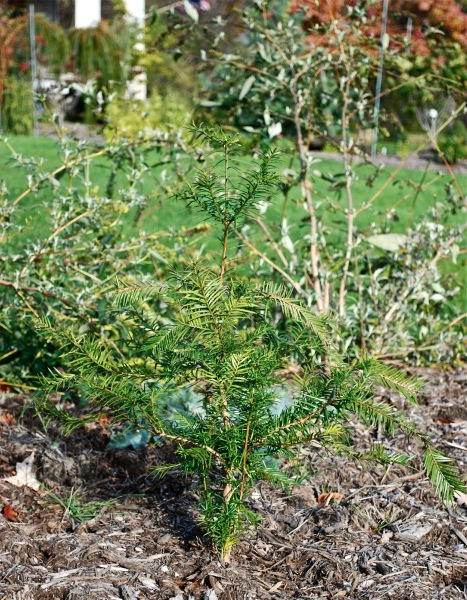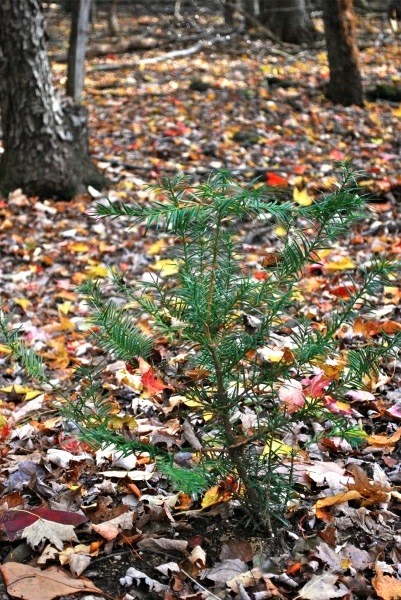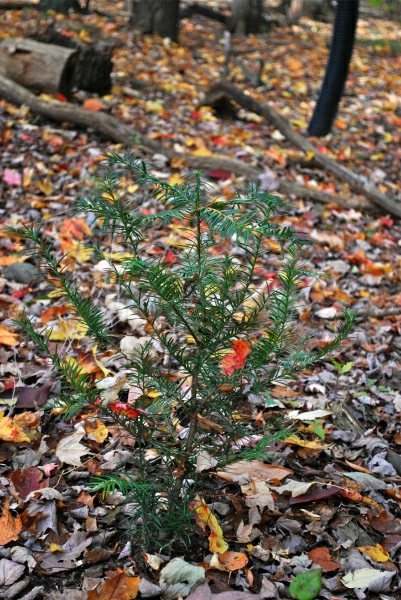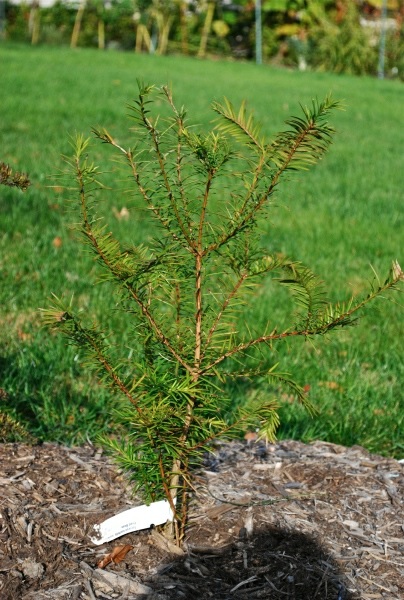Parma, Ohio (a suburb of Cleveland)
Report by private landowner, Fred Bess
|
Provenance: The torreyas in his front yard were all were purchased in 2009 as potted seedlings during a site visit to Woodlanders Nursery in South Carolina. The provenance of those seedlings has been attributed here (on p. 26) to the female Norlina tree and male Henry Foundation trees.
Fred Bess is professionally a landscaper, avocationally an admirer and grower of plants. Torreya taxifolia is just one interesting species in his collection. Contact:
Fred Bess
Fred has also published on his methods for propagating orchids in his basement: "A Hobbyist's Guide to Growing Orchids from Seed, 2022, Orchid Digest.
LEFT: Fred shows his 15-year-old, cutting-grown Dawn Redwood (2018).
DESCRIPTION OF HIS TORREYA TREES (as of November 2024): I have 5 trees: 3 female, 2 male. One of the male and female trees were apparently from the same seed; two embryos from one seed makes them fraternal twins, it would seem. Four of the trees are planted in a raised bed "island" and are 10 feet apart (intended as an eventual screen from street lights). The last is a cutting-grown female and situated about 75 feet from the set of island trees.
• Late October 2025/ Fred Bess/ Seed harvest from all 3 females
LEFT is the collection from the big female. She took a bit of time off and produced a fewer number of seeds, but with large arils. MIDDLE is from the twin-trunked male/female tree. Best harvest to date from that tree. RIGHT is from the cutting-grown tree. Again, best harvest from this tree to date. I have seeds available to anyone who wants them. I only stipulate east of the Mississippi River in order to help prevent cross-pollination with T. californica. Additionally, I have a large quantity of seeds available from the big female from 2024 that are about to go into second stratification. That seed stock enables enables recipients to get a one-year head start (on the usual two-years of winter stratification). • August 15, 2025/ Fred Bess/ Cutting-grown torreya in OHIO is loaded with seeds
• Late June 2025/ Fred Bess/ Florida yew photos and info
Here are pictures of two of the Taxus floridana. • Early June 2025/ Fred Bess/ Seeds growing on 2 of the 3 females


• Early May 2025/ Fred Bess/ Minor frost damage from -5F winter low
Fred took the PHOTOS BELOW in early May 2025. He wrote, "The windward southwest (and streetside) had some tip and needle damage. The northeast (leeward) side of the trees sustained no damage at all."
ABOVE: The orchard of Florida torreya trees on its northeastern side. Glimpses of the road are visible behind the torreyas. The left-most tree is male, the rightmost is female, and the center tree is a two-stemmed hermaphrodite (the main stem is male and a secondary is female).
ABOVE: This is the southwestern side of the grove, which is generally the windward side. Unlike the leeward side, here you can spot some noticeable browning. This side is also vulnerable to salt spray from the road during the winter. The two stems of the hermaphrodite extend beyond the top of the frame. Fred's house is visible above the right side of the grove.
ABOVE AND BELOW: Close-up views of the worst frost damage during the winter of 2025. This kind of branchlet die-off manifests as a kind of pruning. New growth makes the outer form denser, which can protect overwintering reproductive buds from windchill dessication.
Fred wrote, "All in all, the damage was not nearly as bad as the -17F they survived back in 2014."
• January 2025/ Fred Bess/ Methods of sending and stratifying torreya seeds
They go through winter under the bench, then in spring and throughout the season, I check the bag periodically for germination. Any seeds that have germinated, are removed and potted. Those that have not germinated remain in the bag. I continue to check them until winter comes. I continue this for several years, removing seedlings and replacing the rest.
• November 2024/ Fred Bess/ Photos of the torreyas in front yard
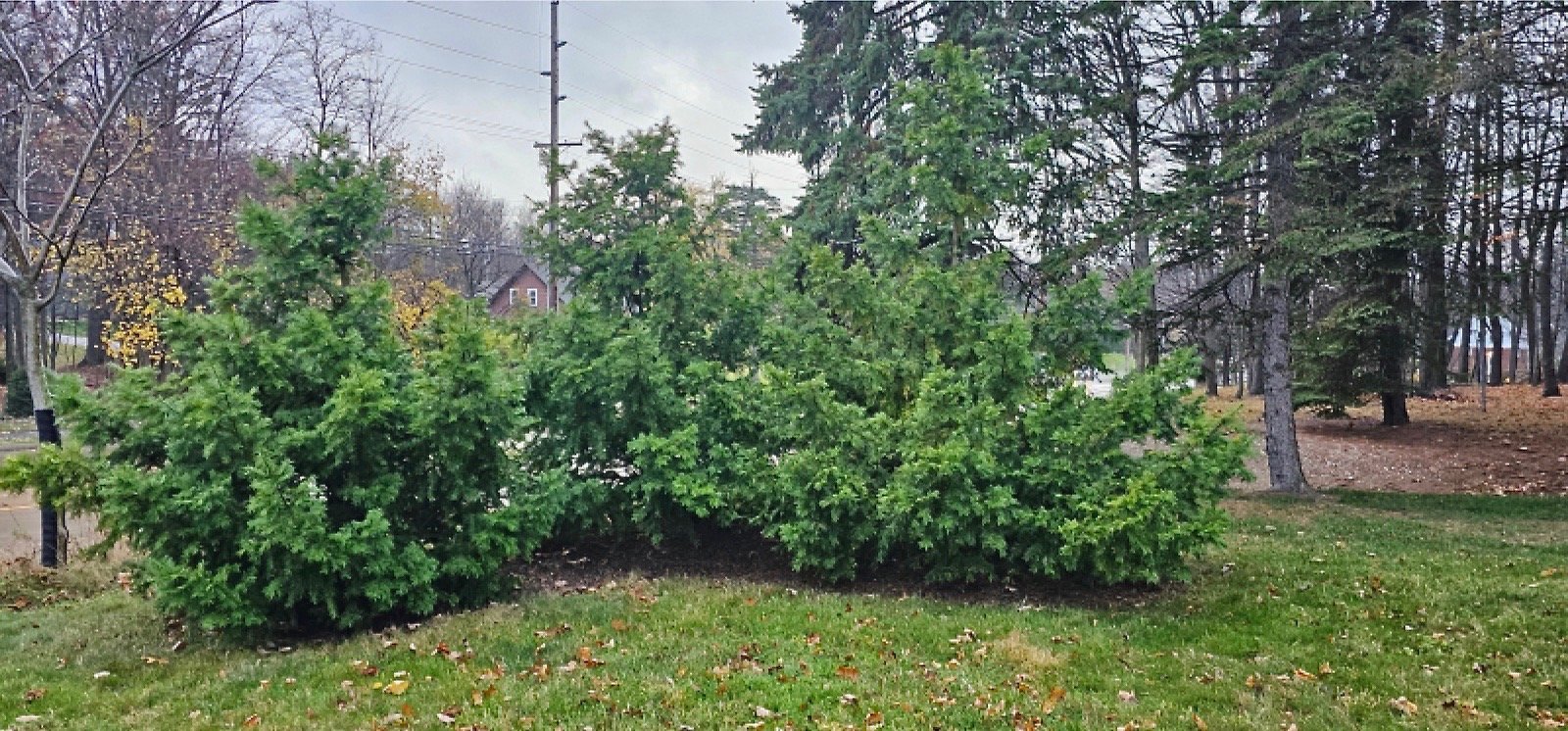
• November 2024/ Fred Bess/ Parma, OHIO, photos of seed harvest from 3 female stems
FINAL COUNT:
Big female: 1,082 seeds
• November 2023/ Fred Bess/ Parma, OHIO, photos of seed harvest from 3 female stems
Fred Bess (Parma, OH) says,
• October 2023/ Fred Bess/ Parma, OHIO, has another big torreya seed harvest
Fred Bess (Parma, OH) does it again! He writes in part,
• July 2023:
ABOVE: "I was out doing yard work and noted that the big female in the front yard is absolutely loaded with arils/seeds."
• May 2023:
"Have been getting ready for my big plant sale to benefit Secrest Arboretum yesterday. That is now complete and a huge success. I sold many rare southeastern native plants and 4 of the supposedly hardier Sequoia tree seedlings."
Editor's note: A few days earlier, Fred had stepped into a Facebook debate initiated 30 January 2023 by a post by Adam Black. Adam's post on his recent visit to "the ravines along the Apalachicola River in northwest Florida checking on some Torreya taxifolia with Lilly Anderson and Liz Thomas" included this statement: "... Sadly there is a group called the Torreya Guardians who still subscribe to the outdated theory that these trees were going extinct due to not having shifted north to cooler, higher elevations/latitudes after the last ice age." Many comments pro and con the Fusarium pathogen hypothesis, supported by Adam Black, ensued. Here is Fred's contribution to that Facebook thread:
1. It should be relatively easy to prove if the Fusarium is native or introduced as there are many T. taxifolia trees growing far from the native stands that predate the onset of the disease in the native range. Those trees could be tested to show whether the disease is native or introduced. I know science isn't always that cut and dried, but it would give a pretty good indication would it not?
Finally, as I write this my male Torreya taxifolia trees are shedding pollen and that is being received by the female trees. I suspect I'll have another banner seed crop. Last year it was close to 200 seeds from 3 female trees. When they ripen, I will freely offer them to anyone (east of the Mississippi river) for only the cost of postage.
• November 2023:
November 3:
• July 2022:
FRED BESS REPORTS (Parma, OH): "My cutting-grown female has outdone herself! I have counted close to 100 seeds just on 3 branches (pics of two of them attached). I also find it humorous that the bulk of the seeds are on the side facing the male which, as you know, is a fair distance...."
EDITOR'S NOTE: Fred Bess is not only one of our longest-term Florida Torreya planters. He is the record-setter for seed production in the northern states — and he regularly photo-documents his progress.
LEARNING: Because torreya seeds appear nearly full size (and round shape) in early July, even professionals may be fooled into harvesting the seeds too early, in their attempt to prevent squirrels from snatching any. Fred will be waiting another 3 to 4 months before these seeds are harvested. The casing of the seed shell is hidden — and it must fully harden before the seed is removed.
• May 2022:
Note: I may have been premature in thinking that one of those trees is monoecious. I was looking at it with a botanist friend. Upon close inspection, all the female strobili are coming from one main trunk of the tree. I got the tree (as you know) from Woodlanders in SC years ago as a seedling. Jason and I now suspect that the seed had 2 embryos and has produced "conjoined" fraternal twins as it were: one trunk male, the other female. I suppose we will never know for sure.... Even though it looks like I have 3 trees out front, in reality I have 4.
• May 2022:
FRED wrote in an email of 31 October 2021:
• Mixed-up monoecius tree on front hill: 30 seeds
• Cutting-grown shrubby tree in back: 37 seeds
• August 2021 / Connie Barlow / Fred Bess and his Torreyas growing in OHIO featured photo in new wikipedia page:
Torreya Guardians
• May 2021:
EDITOR'S NOTE: Begin by scrolling down to the OCTOBER 2018 entry to see a photo of what Fred's 3 seed-grown torreya trees looked like back then. It was a year of prolific seed production by the female tree, and also the shrubby (rooted branchlet) female planted 50 feet away. November 2020 Fred reported that the big female bore just 2 seeds. But in May 2021, Fred writes:
PHOTO LEFT: Seeds forming on the cutting-grown female tree.
PHOTO RIGHT: The big male (which is in the middle of the three) is doing great and sheds loads of pollen.
Now for the HUGE news:
The left-most tree of the trio of seed-grown torreyas is decidedly undecided! Recall that this was always the smallest of the trees because deer raked the tree with antlers early on. But now ...
PHOTO: You can clearly see both male and female strobili on adjacent branches.
This lends credence to the fact that T. tax can be either male, female or bisexual. This I find really exciting and had to share immediately!!!
Additionally the PHOTO BELOW shows the results of my attempt to root T. tax cuttings. I started this cutting project December 2019, when I collected 25+ cuttings from the Spring Grove Cemetery tree in Cincinnati.
I followed the guidelines on the Propagation page. Pictured here are the cuttings that worked.
• July 2020:
• April 2020:
CUTTINGS ROOTING: Update on the Torreya cuttings taken in December. Of the six pots I took, these remain: 4 cuttings from the Cincinnati tree and 11 from my two female trees. None of the cuttings I took from the male trees here survived. Not sure what happened. I've yet to try to see if they are rooting (scared to disrupt things by looking). PHOTOS BELOW are of potted cuttings [in Fred's greenhouse]. Notice the fresh YELLOW BUDS prolific on one of the female cuttings.
• April 2019:
• October 2018: OHIO Torreyas produce 23 seeds
• VIDEO: "Seeds of Florida Torreya Produced in Ohio".
Connie Barlow filmed this 2 October 2018 site visit. The VIDEO features important findings, including:
1. These trees have put forth leaves well acclimated to severe cold spells in Ohio. On the windward side of the tree, branch tips are occasionally killed, but a ring of new growth results and the tree becomes plusher and thus even more wind-proof.
2. Seeds are produced only on the branches that receive nearly full sun. (Connie notes from her 2005 site visit to wild California Torreya habitat that this seems to be a standard of the genus.)
ABOVE: The triplet of Torreya trees entail 2 males (left and center) and a female to their right. A row of tall Blue Spruce is visible behind.
ABOVE LEFT: October 2, 2018: Connie Barlow and Fred Bess with the left-most male; notice the bag of deer deterrent.
ABOVE RIGHT and BELOW: Fred and Connie wear leather gloves while searching for seeds on the southwest-facing side of the female torreya.
ABOVE: All 19 SEEDS are on the sunniest side of the tree, and they are all hidden/protected from winter winds by growing on interior branchlets of the kind of dense, Christmas-tree form that Torreya saplings assume when afforded a lot of sun. Surroundings must be mowed to make this possible; otherwise, regrowth forest and shrubs shoot up much faster than torreya can grow. The seeds will become orange-purple when ripe in late October.
ABOVE: A fourth reproductive "tree" came not from a seed but a branch-cutting, so it will likely remain shrubby all its life. It is female, having produced 4 fruits this year — for the first time. Notice the light green new growth reaching skyward. In favorable conditions, Torreyas may show a second flush of vegetative growth in late summer or very early fall.
• May 2018: Set of 4 Torreyas sexed as 2 male and 2 female (with seeds underway)
BY FRED BESS: "Here are a couple of photos of the female strobili on the T. taxifolia. Almost looks as though there are strobili from two different years. Some are very small, while others are a good bit bigger. It turns out that I now know the sex of all 4 trees. Two males two females YAY!" (Final photo is male.)
Editor's note: A USDA webpage on California Torreya is the best place for reliable information on growing habits of Florida Torreya (the two are rather indistinguishable, but California's torreya is still in mountain habitats, so it can adapt to changing climate by slope and elevational shifts.)
• November 2017: (by Fred Bess): First Torreya seeds produced in Ohio!
Fred Bess announces the Torreya triumph in this November 17 email to Connie Barlow:
Could this be the first T. tax to seed set in the state of Ohio in thousands of years?
The female is the plant on the right, male in the middle. The one on the left that was damaged by deer [autumn 2014; see photo far below] has yet to show me what sex it is.
I knew the sex of two of the four Torreya trees as male. [See the photo of July 2013 of a shrubby male Torreya, which will never become tree-like because it was propagated from a rooted branchlet, not from seed.] Both produced pollen cones in 2016. The possible female bud photo I shared in 2016 [see photo and caption below] turned out to be male cones. I have yet to see what an immature female cone looks like. The female cones (arils) on the confirmed female tree were tucked way down and deep within the tree, so they went unnoticed until they were fully mature. They could have perhaps been pollinated in 2016 and taken two seasons to mature, but I have no way of knowing. That said, I will have to be diligent and watch this tree to see what occurs and do close inspections on the tree at the time when the male tree is in shedding pollen. In doing so I should be able to confirm how long it takes for arils to mature.
• December 2016: (by Fred Bess): End of year PHOTOS of all 4 Torreya plants
Note: The dangling white packets contain herbs for repelling deer.
Fred has discovered that seedlings outplanted their first year of germination are usually root-killed by rodents (as the large below-ground seed still contains plenty of nutrients).
But by their second year the seed is virtually empty, hence rodent predation is merely vegetative bud nipping (which damages but does not kill the plant).
• October 2016: 2016 excellent season for Ohio Torreyas
• May 2016: One Torreya has its first male cones
Photo RIGHT is of the cutting-grown specimen that, because it is a rooted branchlet, will always stay shrubby. Fred's hypothesis is that the little buds at the base of where new leaves are emerging might be female reproductive structures. (We know that a branchlet cut and rooted from a mature tree will produce reproductive structures at a "young" age, as the plant maintains the physiological memory of being a mature branch.)
• February 2016: "I have gotten almost 100% germination on 150 seeds from the 2014 crop. As of now there are only 13 seeds that have not sprouted. It would seem they germinate better after double stratification [2 winters]...."
"When they arrived I put them into a 1-gallon ziplock bag with about 4 cups of slightly damp peat/soil mixture and placed it under the bench in my greenhouse (temperature rarely dips below freezing there). "I checked the bag beginning Spring 2015 weekly and removed any that germinated, then resealed the bag and placed it back under the bench. "I hadn't looked at the bag since about Thanksgiving 2015. To my surprise, today (February 6, 2016) I found that all but 13 of the rest of the seeds have germinated. Most are just showing the radicle; a few have sprouted significantly."
• March 2015: (by Fred Bess): Florida Torreya survive historic cold winter near Cleveland
We had the coldest February on record: 10 days below zero (including days when the 'high' was zero). We also had a record-setting -17F. That's the second coldest ever recorded in Cleveland, coldest was -20F in 1994.
LEFT is the first of the three Torreyas on the front hill. At some point during the winter a buck ripped away the fencing and raked his antlers; this is the second year this tree has been damaged by bucks (I will be getting some better fencing to protect the trees). It looks the saddest of the bunch, but I am certain it will recover quickly.
RIGHT is the tree on the corner; it looks quite good, with only a little bit of damage from the winds.
LEFT is the last of the three trees on the front hill. It always looked funny because it failed to produce a good leader until this past year. So it looks a little plump at the bottom and skinny at the top. But again, it suffered little damage from the winter.
RIGHT is the cutting-grown plant back towards the greenhouse. It had virtually no damage at all this winter.
[Editor's note: Cutting-grown Torreya trees (from rooted branchlets) are notorious for never really figuring out they are a tree and that they need to grow vertically; instead, they keep thinking they are a branch and so they grow outward and brushy.]
[Editor's note: Needle Palm grows in the same habitat as the remaining Torreya trees in their historically native range along the Apalachicola River in northern Florida.]
APRIL 2021 UPDATE from Fred: "Rapidophyllum hystrix, needle palm has produced seed!"
I can say that I didn't have as many other non-native plants killed outright this winter as last (at least that I know of so far). But the Cephalotaxus that came through okay last winter did not do as well this year; it has quite a lot of burn on the needles, even though I sprayed it with anti-desiccant.
I have a lot of Torreya, Persimmon, Ginkgo and KY Coffee tree seeds to spread around this spring! I'll document and keep tabs on where and when they are planted, so that I (or someone in the future) will be able to follow their progress.
• October 2014 (by Connie Barlow): 2014 VIDEO report of Torreya project Cleveland, OHIO
Importantly, Fred reports that sapling protection is needed only during the antler season, as even overpopulated deer accustomed to eating domestic plants that wild deer would shun perform no more than a nibble of a taste test on this unfamiliar species before determining it is not a food source.
• July 2013:
I sent 20 seeds from the 2011 Torreya Guardian seed harvest to Secrest Arboretum in Wooster Ohio (which is affiliated with Ohio State University). Of those 20, 13 have germinated (photo left).....
The seeds were planted only barely below soil surface by one of the graduate students, Paul Snyder, who also works at the arboretum.
He was able to carefully move soil from around the large seed with fine brushes and small trowels to see the root development.
As for the plants here at my home, 4 of the 5 are doing very well! The plant in the woodlot is struggling, and if I can find a better home for it I will relocate it. Like almost everything else I plant in the woodlot, it just is doing poorly.
Last time I wrote I mentioned that all 6 plants were doing well; sorry, guess I cannot count. I have only 5. The cutting-grown plant is really taking off, becoming a bush and I think may be male. The other 3 seed-grown plants that are out in the open are also doing well; one has put on 4 inches of new early spring growth and are starting to flush with more growth. I have attached photos of the plants (except the one in the woodlot). Those unnamed photos are the seed-grown plants from Woodlanders Nursery. One appears in the photo to be leaning; it is not — just a breezy day.
ABOVE AND BELOW: Photos of the single plant rooted from cut branchlets; so it is brushier in form and will mature soon.
ABOVE AND BELOW: All 3 potted seedlings plus the shrubby rooted branchlet are all doing well in full sun.
• January 2013:
• November 2011: This site received 20 seeds from the Fall 2011 Torreya Guardian seed distribution.
ABOVE: Oct 2011 photos of cutting-grown plant purchased on E-Bay in 2006.
I became interested in the genus Torreya in 2005 while visiting a private arboretum in Stow, Ohio. I did a bit of reading and learned of the plight of Torreya taxifolia. The following year I happened on a plant (cutting grown) on Ebay and purchased it. It spent the first winter in my cold attic with most of my other plants that need cold treatment but no freezing temperatures. It did not fare too well but did survive. I planted it out spring of 2007.
While it does not look like a nice conical/typical conifer [in the 2011 photo above], I attribute this to it being cutting grown from a lateral branch. It has survived and grown nicely with absolutely no wind or freeze damage, and in the winter of 2008/2009 it survived -13F.
PHOTO BELOW: A seed-grown plant purchased from Woodlanders Nursery, SC, and planted in a sunny spot near Cleveland, Ohio.
I overwintered the plants indoors the first winter. The third plant was overwintered in an alpine greenhouse but developed Phytophthora or a similar looking disease problem and died.
The following year (December 2010) I made the same trip south and again ordered and picked up an additional 2 plants of T. tax. The four seed-grown plants, as well as the cutting-grown plant, have established nicely. Three are located in a prepared bed in a relatively exposed location. One is planted in a woodland situation, and the cutting-grown plant is in an open but protected area not far from a T. yunnanensis, which will have to be removed depending on the health and vigor of the T. taxifolia. [Editor's note: T. yunnanensis is an Asian species of genus Torreya; if it turns out to be a male tree, removal will ensure no pollen contamination of the taxifolia females.]
As of this writing (October 2011) all 5 plants are doing quite well, though I have noted a bit of deer browsing on one (protection is already in place!). I will send more pictures of the plants after ALL have gone through an Ohio winter.
SEE BELOW FOR PHOTOS OF THE OTHER SPECIMENS:
Contact Connie Barlow OR
Contact Fred Bess
Return to HOME PAGE
Annotated List of Papers/Reports Online re Assisted Migration
|
